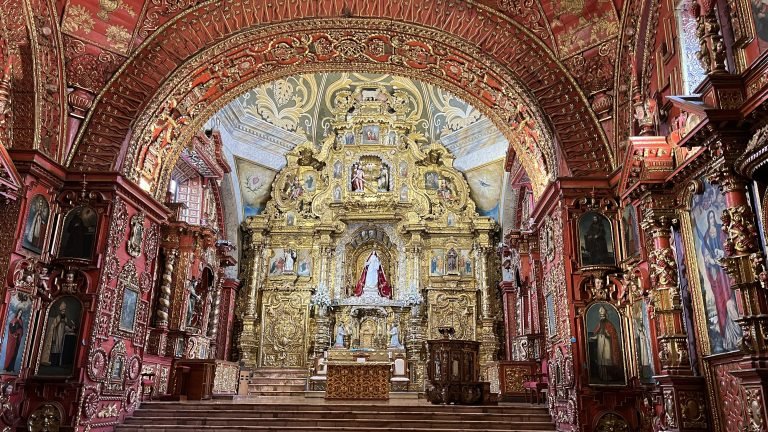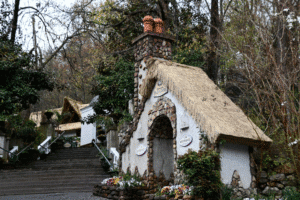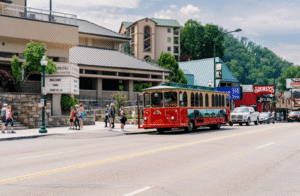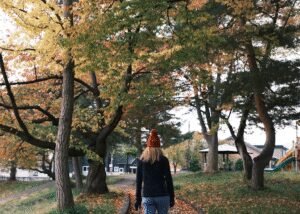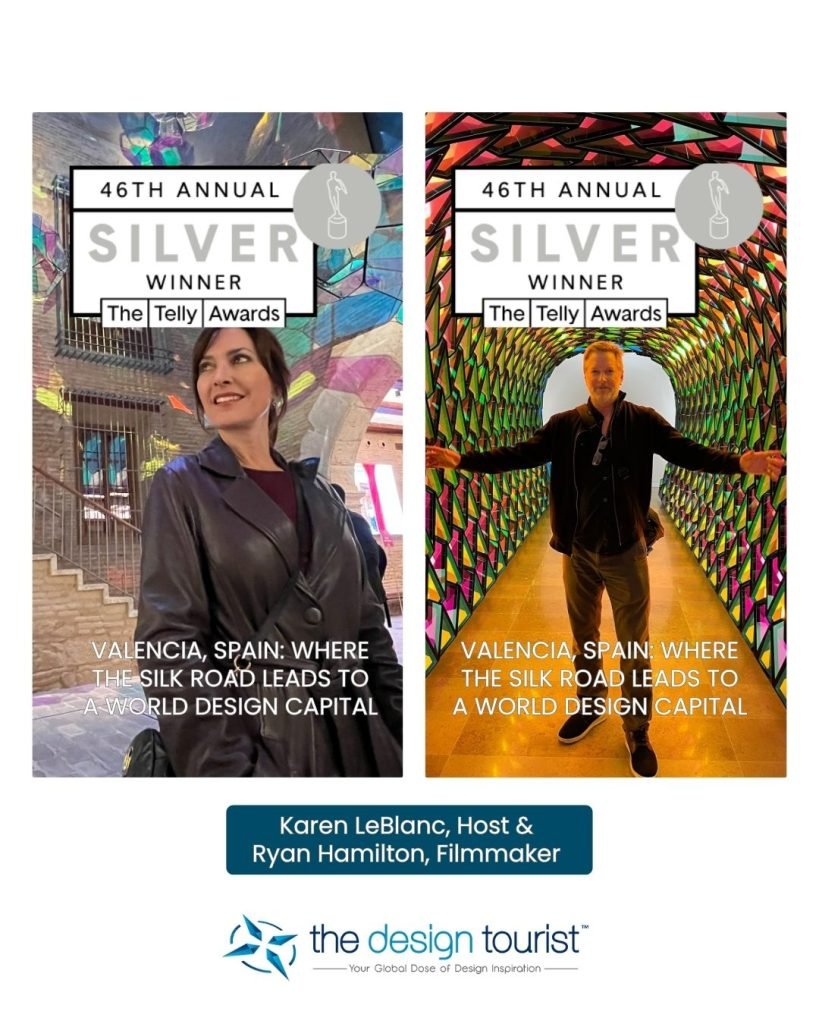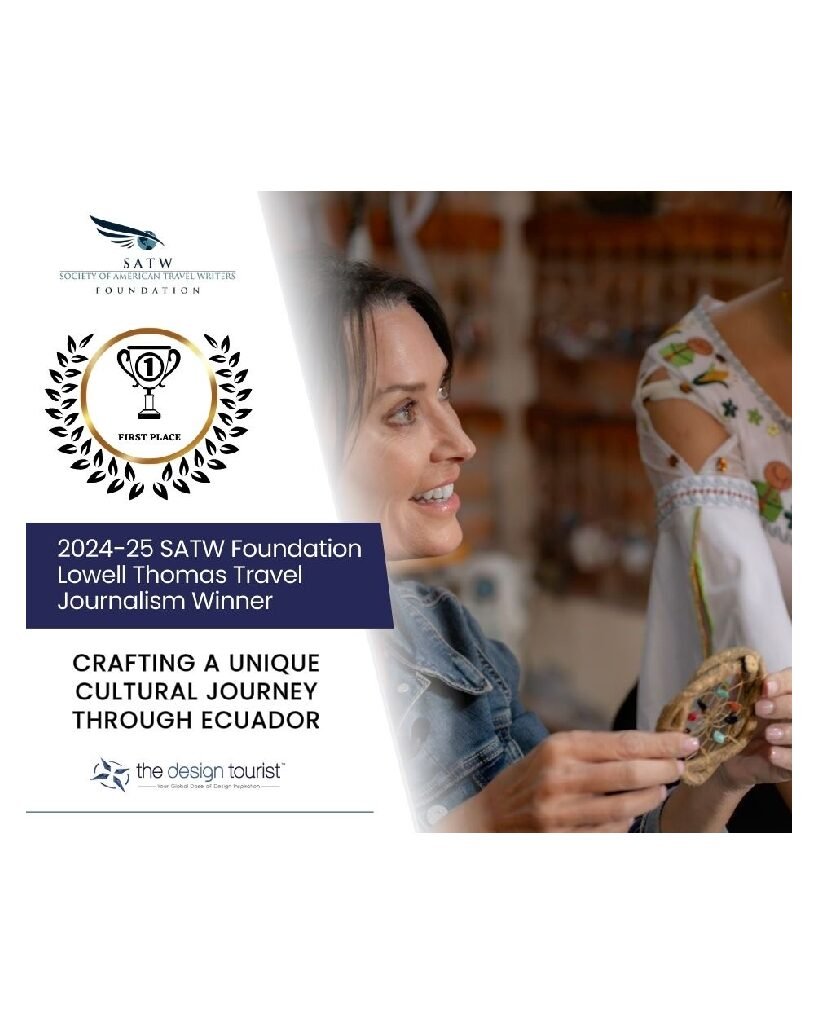As Spanish colonists evangelized Ecuador, they built elaborate catholic churches that were in need of trained artisans. Missionary orders, including those of the Jesuits, the Franciscans, and the Dominicans, brought Catholicism to Ecuador and a penchant for the European Baroque style.
They established workshops and trained local artists, blending European techniques with indigenous talent and creativity. These workshops were collectively known as the Quito School of Art. Quito’s original Inca inhabitants learned to create paintings, sculptures, and designs in the fashionable baroque style at the time.
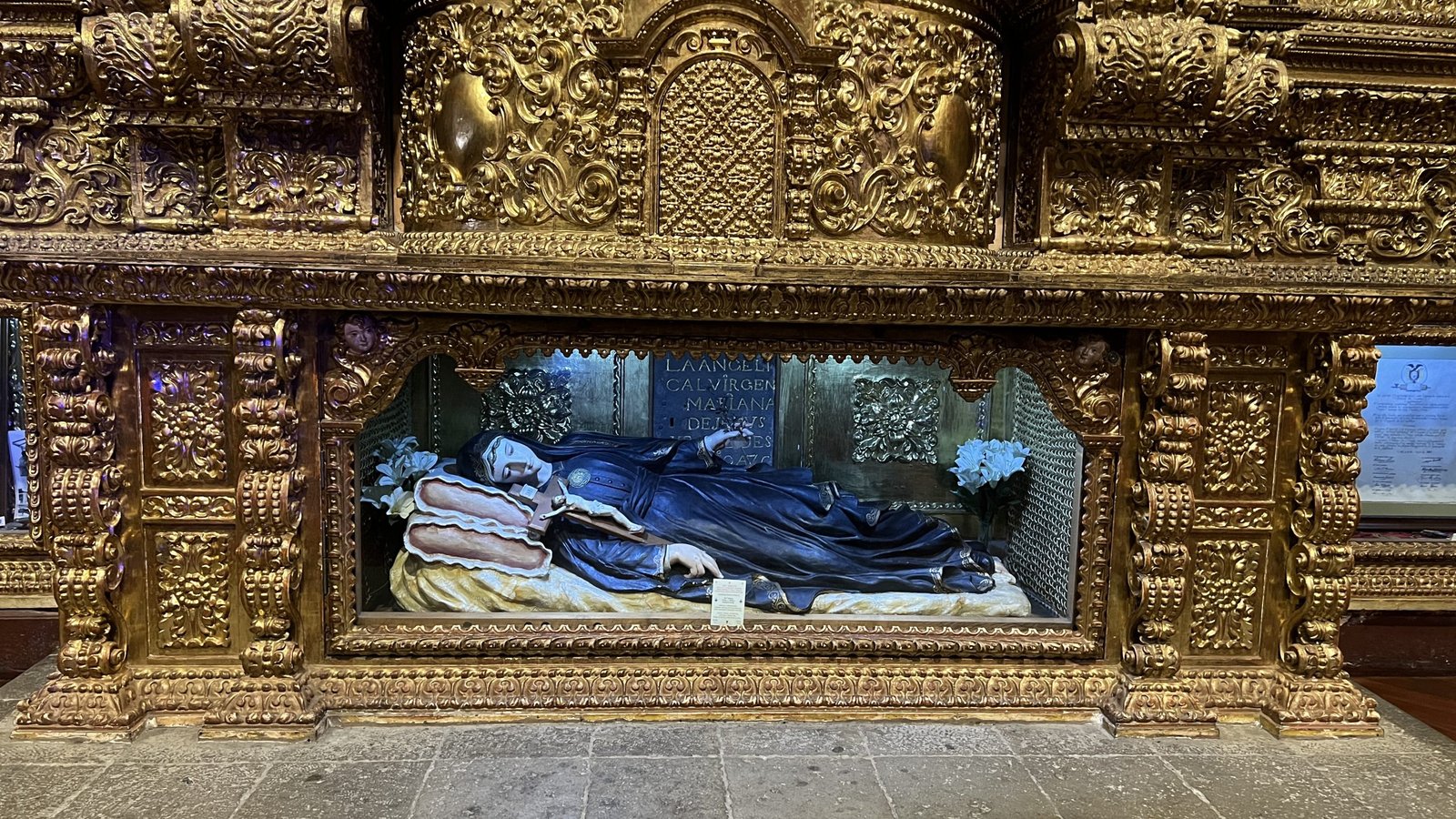
Their artwork can be argued as an act of resistance to Spanish colonial assimilation as Indigenous artisans infused cultural symbols and references in the religious art commissioned by churches. This became known as the Quito School of Art, which produced a fusion of Baroque style with Indigenous interpretations and symbolic references.
A concentration of these cathedrals resides in Quito’s historic district, a UNESCO World Heritage site since 1978. The monasteries of San Francisco and Santo Domingo, and the Church and Jesuit College of La Compañía, with their rich interiors, are pure examples of the ‘Baroque school of Quito’, which is a fusion of Spanish, Italian, Moorish, Flemish and indigenous art.
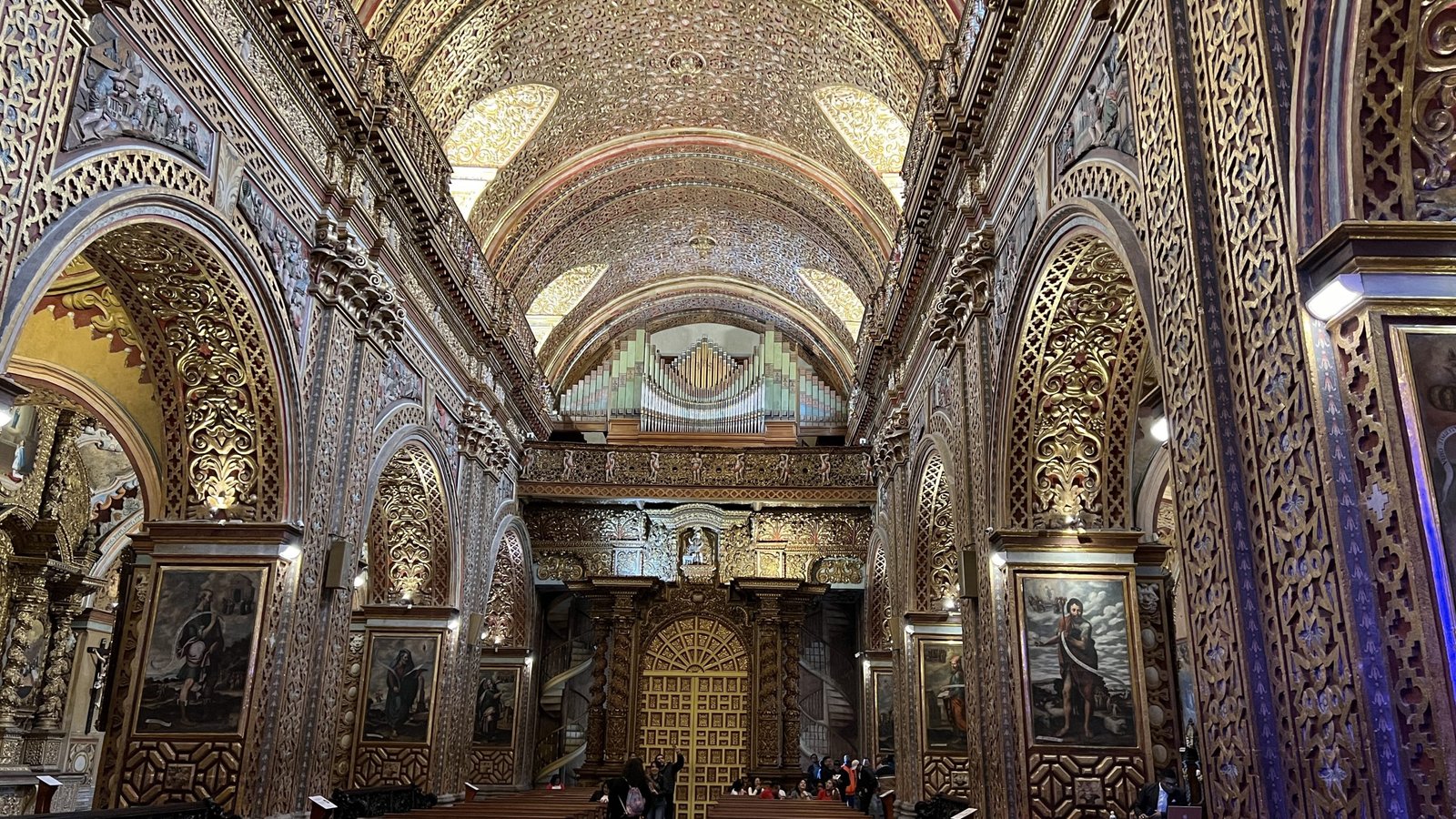
To understand Ecuador’s artistic and cultural evolution after the Spanish conquest, I toured several notable cathedrals that showcased the artistry of the Quito School of Art.
Every inch of the cathedral’s interiors is covered with intricate gold leafing and colorful carvings using cedar wood and native pigments. Polychrome sculptures command attention with realistic renderings of saints using real hair, glass eyes, and resin tears.
Table of Contents
How Spanish Colonial Evangelism Created a Unique Religious Artform
Spanish colonial evangelism was instrumental in creating Ecuador’s unique religious artform. Missionary orders used art as a tool for evangelization, aiming to inspire awe and devotion while spreading Catholic teachings. To achieve this, they founded artisan workshops that trained Indigenous and mestizo artists in European techniques such as oil painting, gilding, and polychrome sculpture.
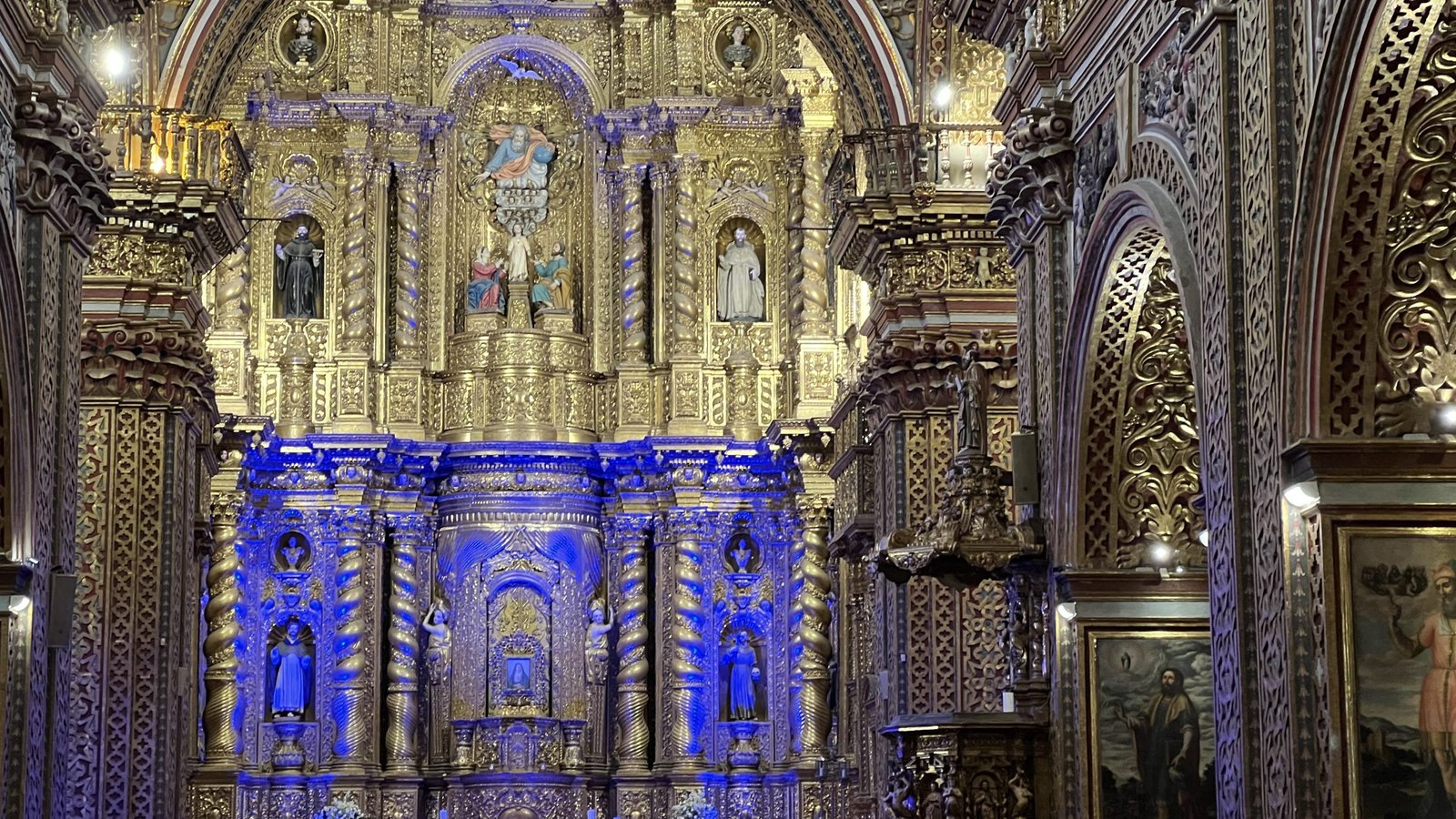
The uniqueness of this artform lies in its fusion of European Baroque styles with Indigenous creativity and symbolism. While missionaries sought to impose Catholicism, Indigenous artists subtly incorporated Andean flora, fauna, and cosmological symbols into their works, creating a distinct visual language. This interplay of cultural influences resulted in religious artworks that were both a reflection of colonial influence and an expression of Indigenous identity.
Masterpieces from the Quito School of Art—found in churches like La Compañía de Jesús, San Francisco, and Santo Domingo—exemplify this artistic blend. These works showcase intricate gold leafing, lifelike polychrome sculptures, and dramatic depictions of saints, making them a cornerstone of Ecuador’s religious art legacy.
The Dominicans influence on the Quito School of Art
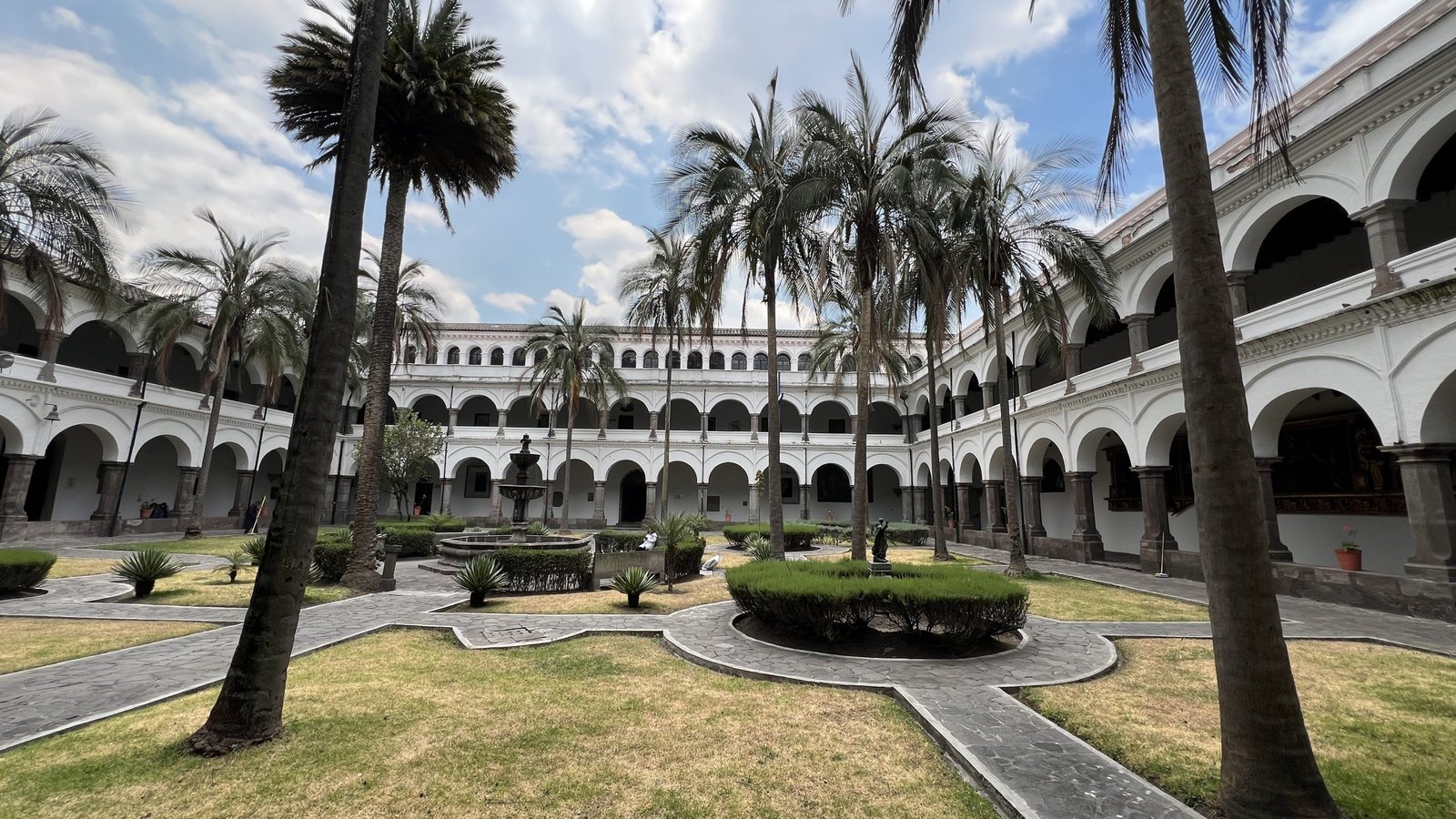
To understand the origin and evolution of the Quito School of Art, I visited the Dominican Monastery known as the Convent of Santo Domingo, fronting Plaza de Santo Domingo. The Dominican Order arrived in Quito in 1541, shortly after the Spanish conquest, and began construction of the monastery in 1546, a blend of Spanish Baroque, Moorish, and Indigenous influences. The Domes of Santo Domingo Church and Chapel of the Rosary are notable features of the campus that includes cloisters and courtyards anchored by the Church of Santo Domingo.
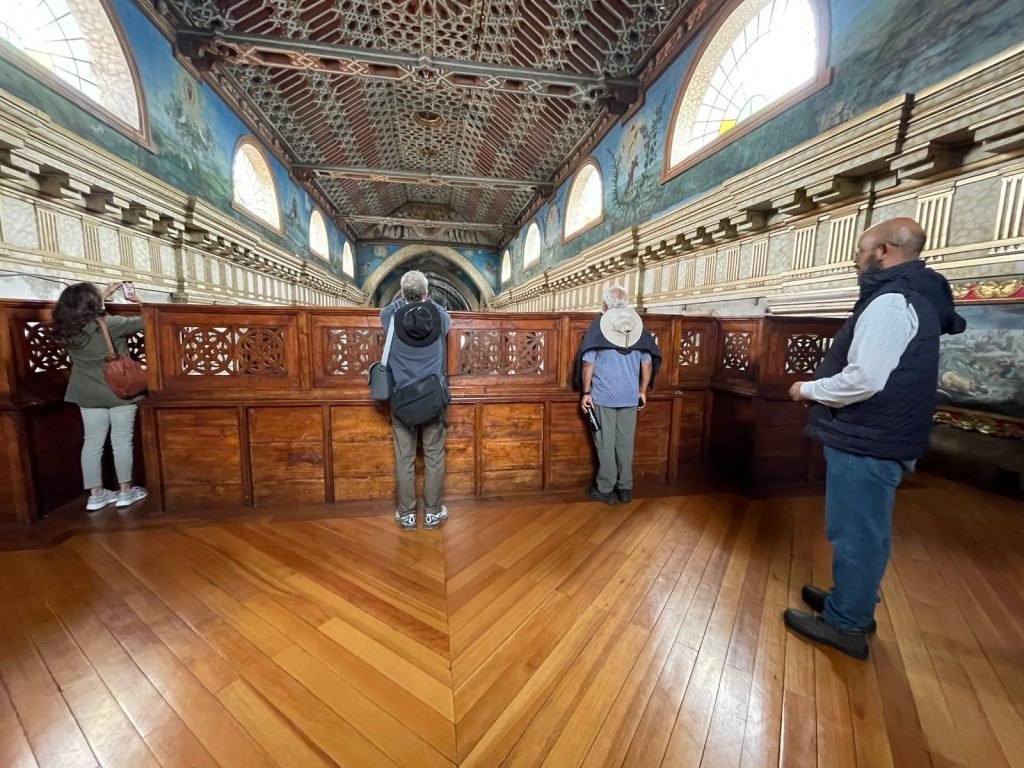
It was initially built by Dominican Priests, with contributions by various notable artists from Quito such as, Bernardo Legarda, Miguel de Santiago and Fray Pedro Bedón. Due to this fusion, the church has a large amount of Baroque as well as Neoclassical details, and a variety of artwork including sculptures and paintings which leave visitors in awe.
The church is an unintentional museum displaying the works of notable artists of the Quito School, including Miguel de Santiago, who are celebrated for his dramatic use of light and shadow. His notable works include The Last Supper and The Virgin of the Immaculate Conception.
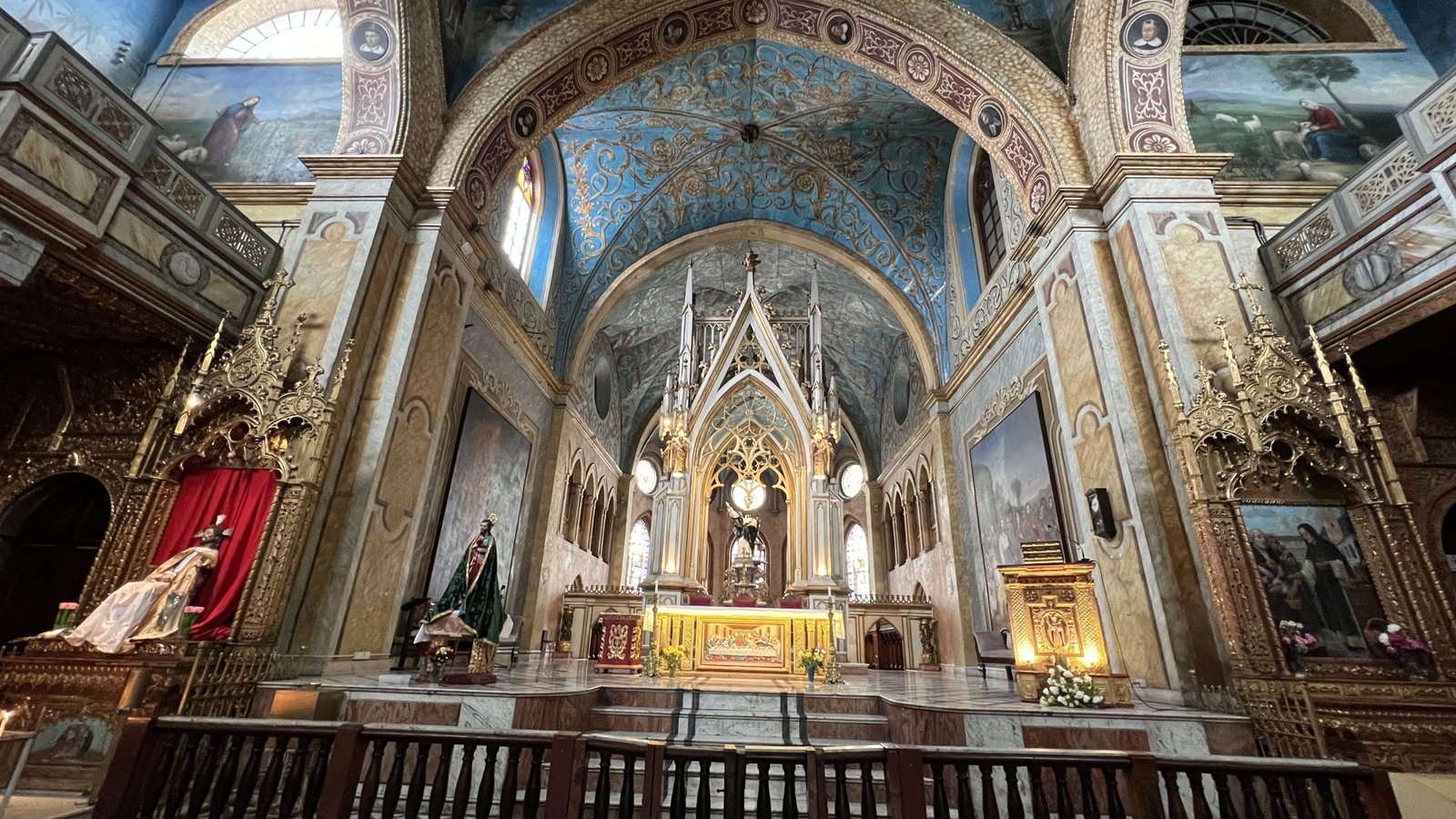
Other noteworthy artists include Nicolás Javier de Goríbar and Bernardo de Legarda painter of the Virgin of Quito, one of the most iconic symbols of Ecuadorian art. I enter the sacristy where the priests prepare themselves, dressing in vestments before performing religious services.
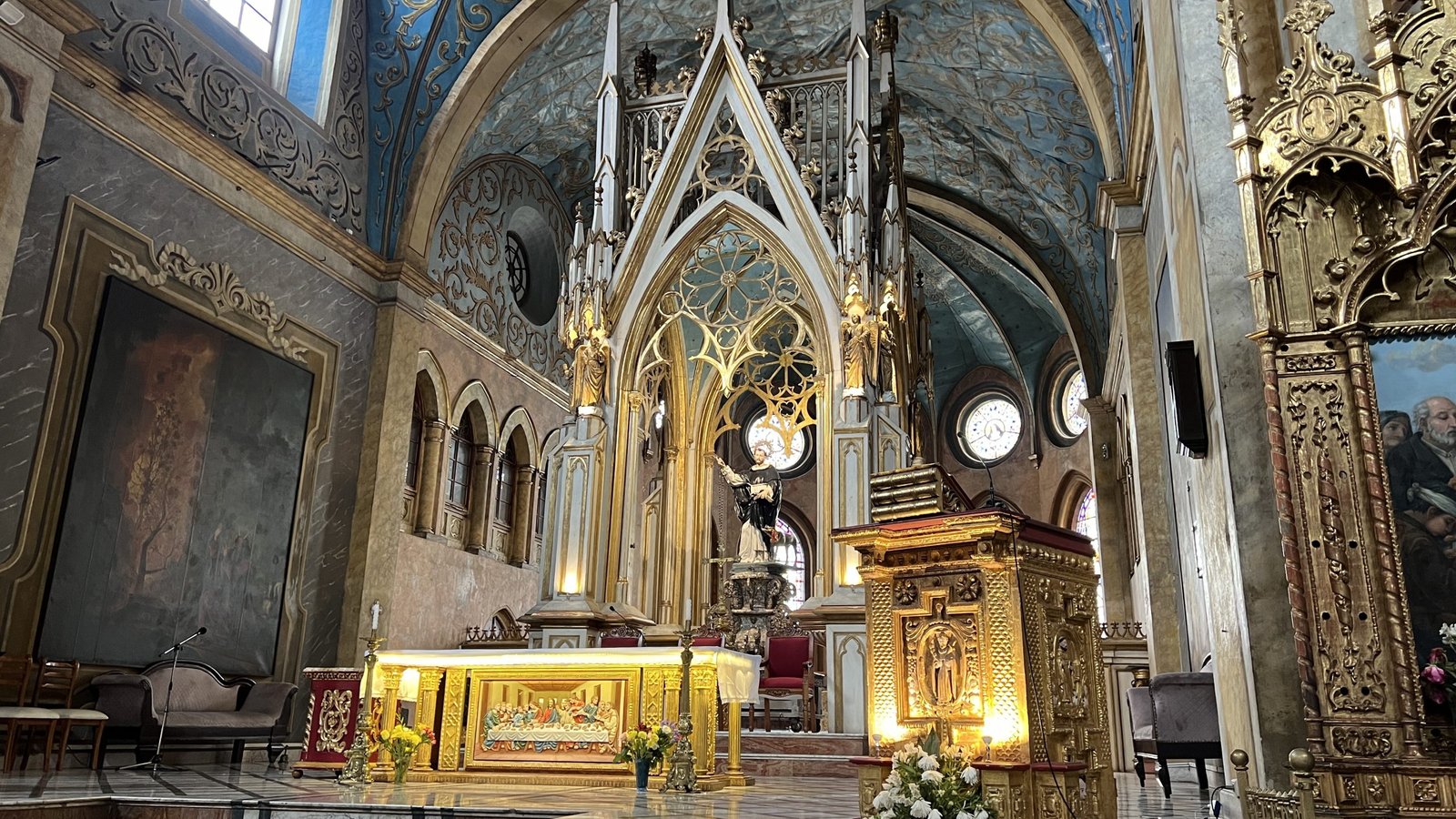
The late 17th century Chapel of La Virgen del Rosario is located on one side of the church’s central nave. Thus creating the famous arch of the Church of Santo Domingo, which supports the Chapel over Rocafuerte Street.
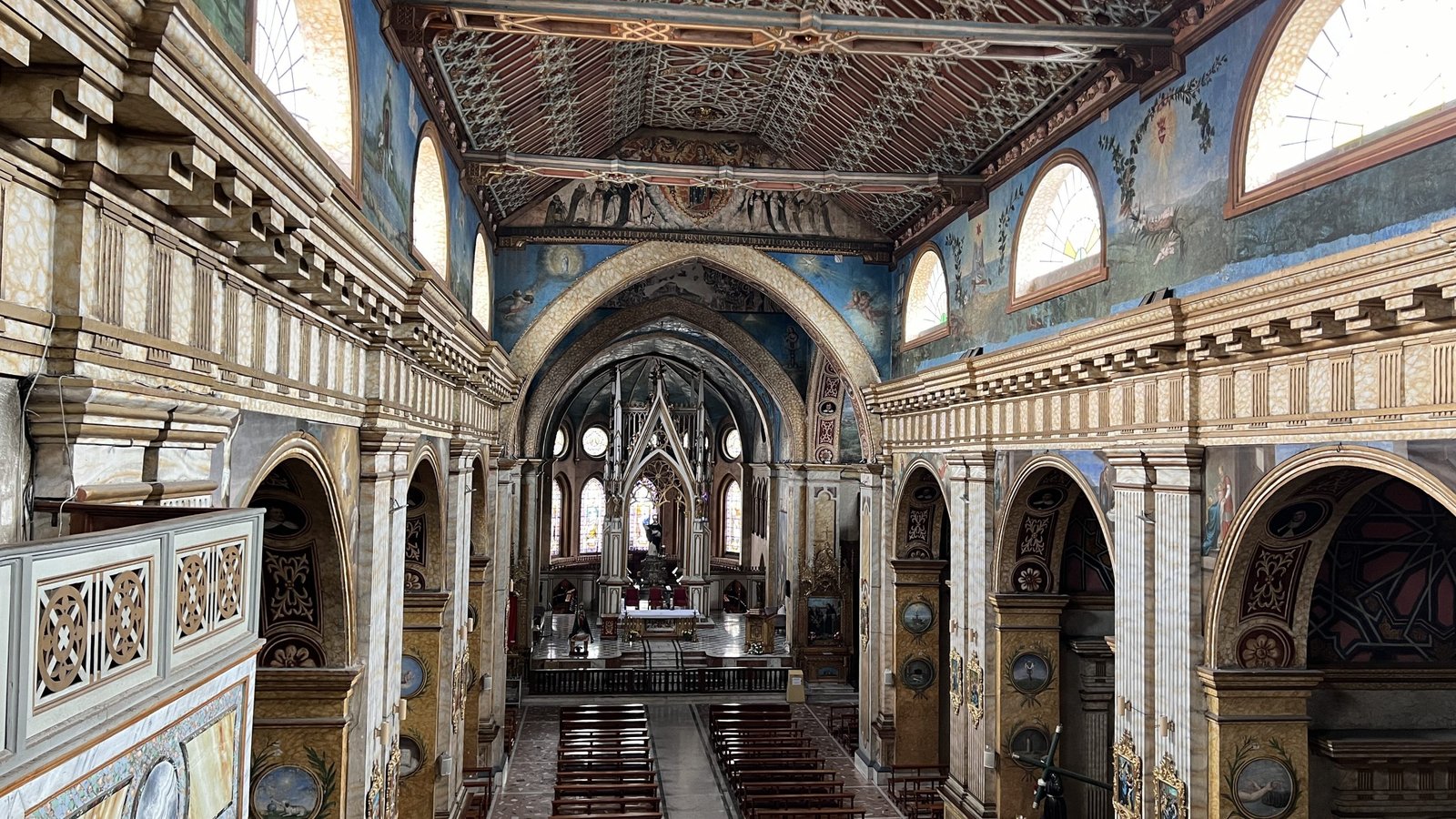
In the chapel you can see the sculpture of the Virgin of the Rosary that was a gift from King Charles V of Spain to Quito. The decoration of this chapel conserves the pure essence of Baroque Quito – golden paintings and carvings on a red backdrop earn its consideration as one of the architectural gems of the historic center of Quito.heir intricate religious paintings stand alongside intricate gold leaf carvings and an ornate central altarpiece dedicated to the Virgin of the Rosary.
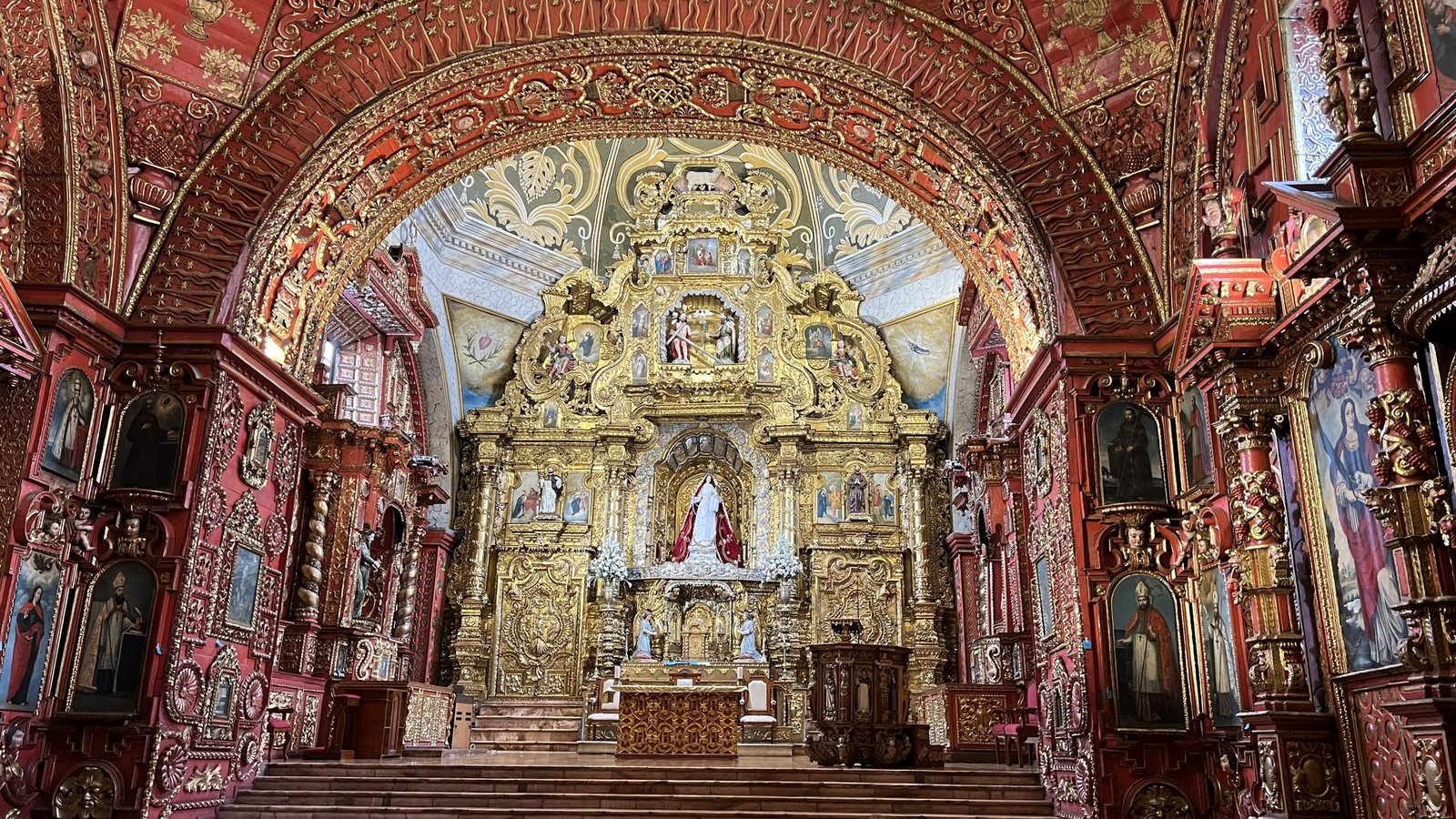
I enter the sacristy where the priests prepare themselves, dressing in vestments before performing religious services.
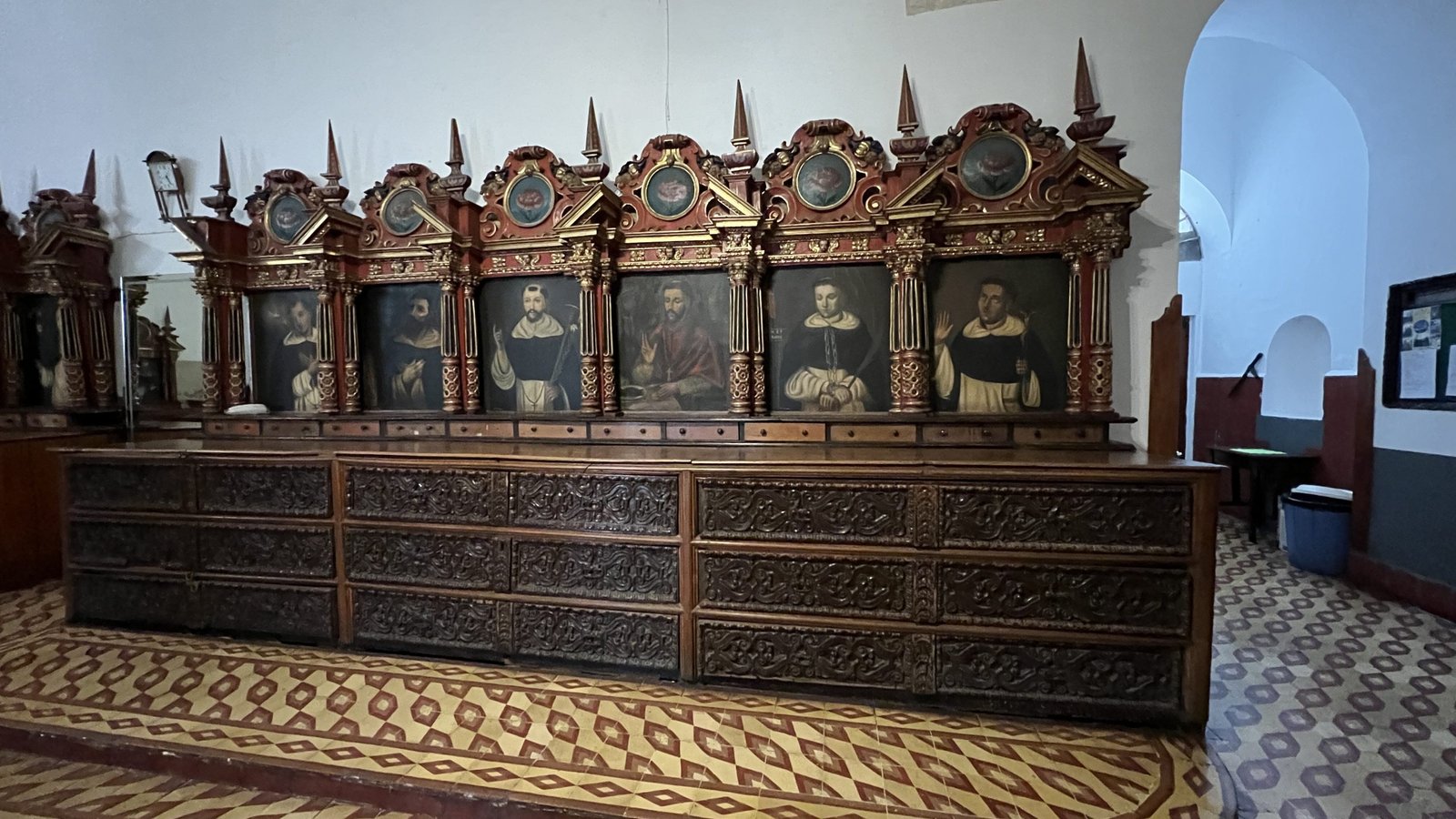
The 18th-century carved wooden lockers hold each priest’s belongings such as vestments the books.
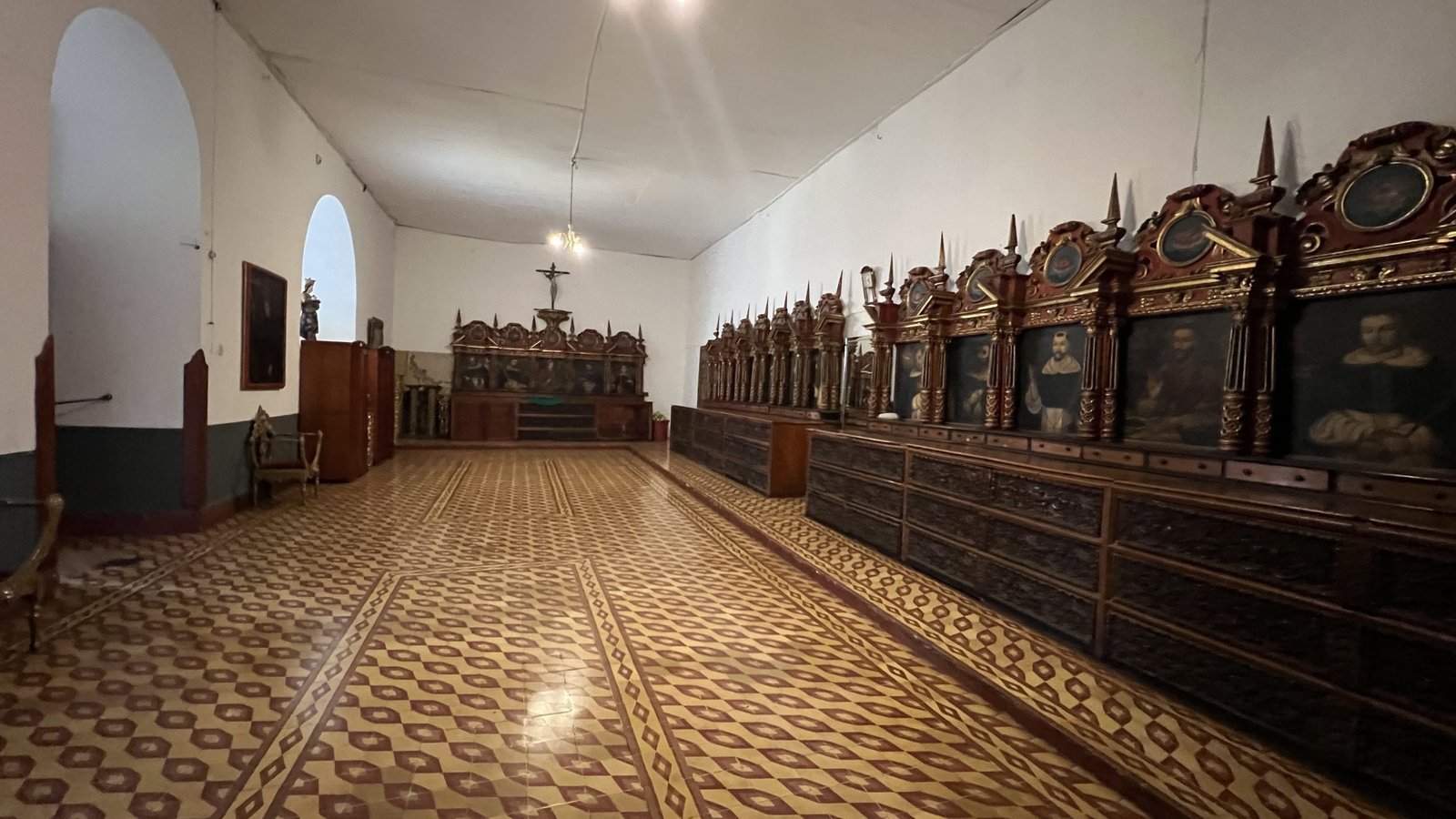
Next, I head to the chapel with huge stained glass windows and an old large songbook from 1671
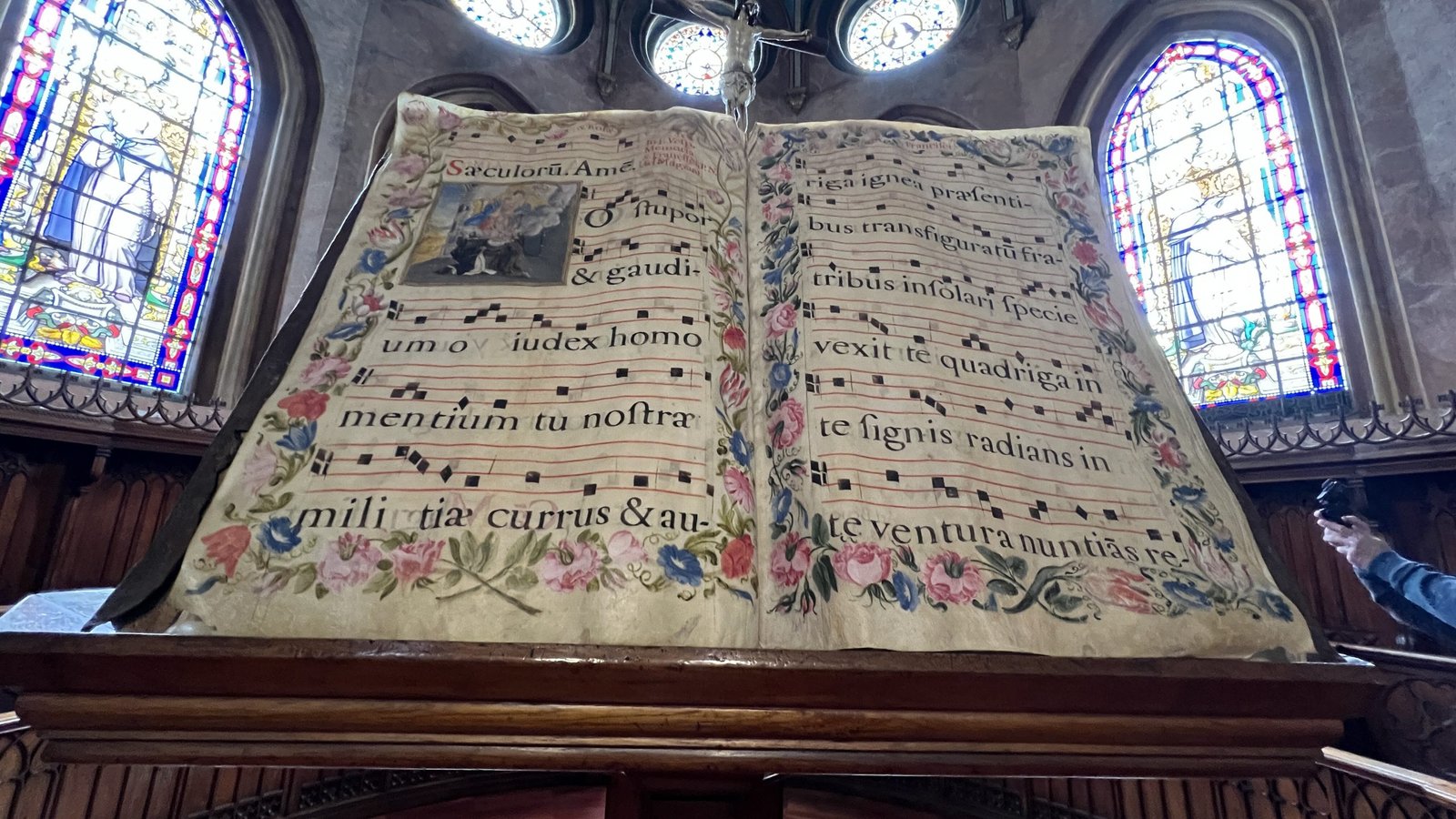
Stained glass windows circle the choir room where a 15th-century music book stands
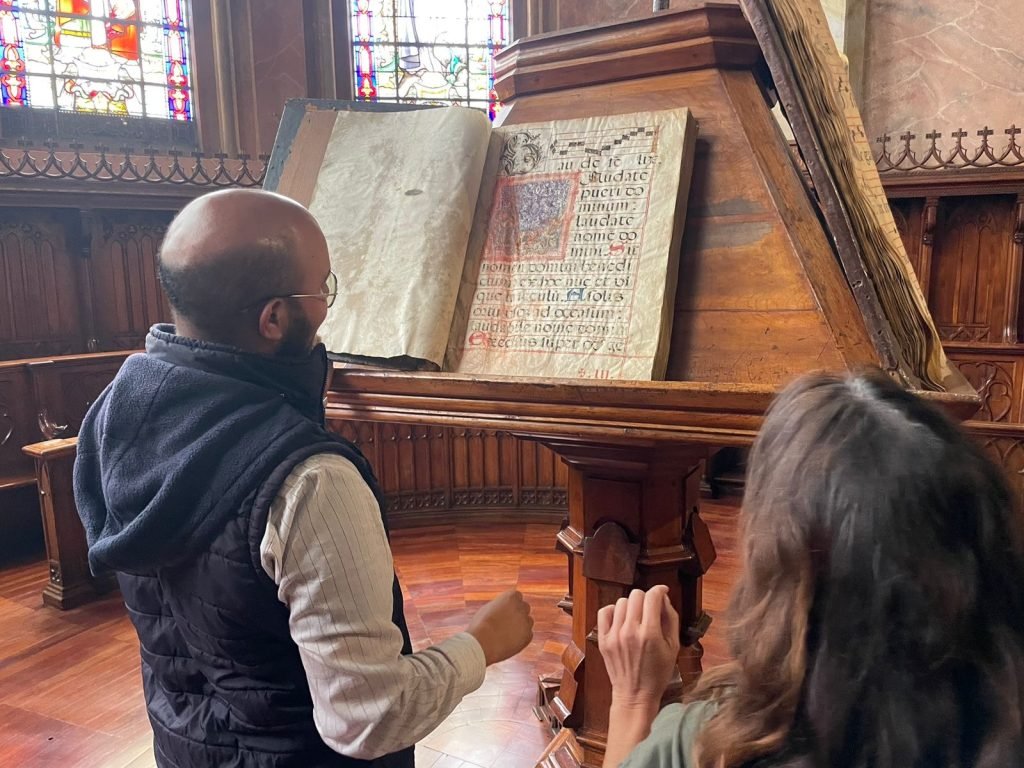
The Dominican monastery was an intellectual center with a two-story library of more than 30,000 ancient books in various subjects such as philosophy, theology, social sciences, architecture, and medicine. Its contributions to education were foundational in shaping Quito as a center of intellectual life in colonial Latin America.
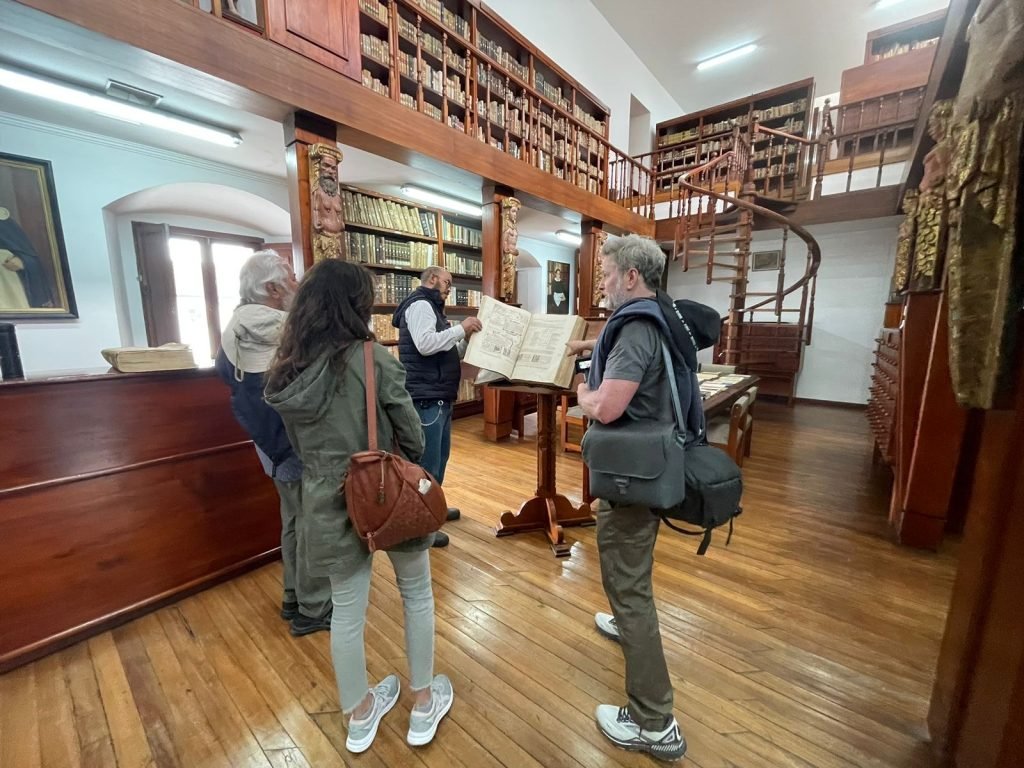
The library holds a bible in multiple languages dating back to 1645 with illustraionts of regions where bible stories take place .
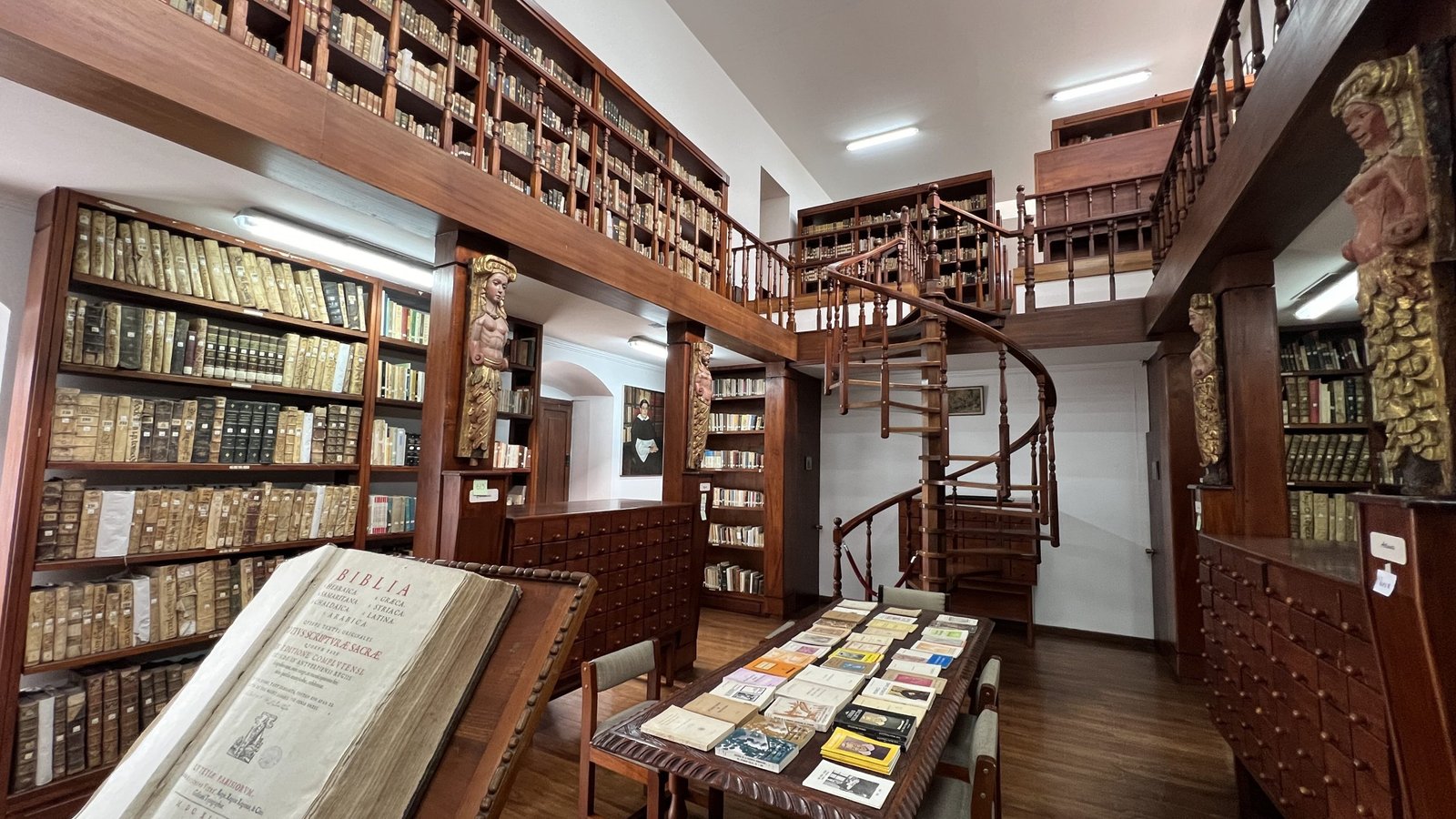
The rooftop of Santo Domingo offers a sweeping view of the city and the Virgin of Quito.
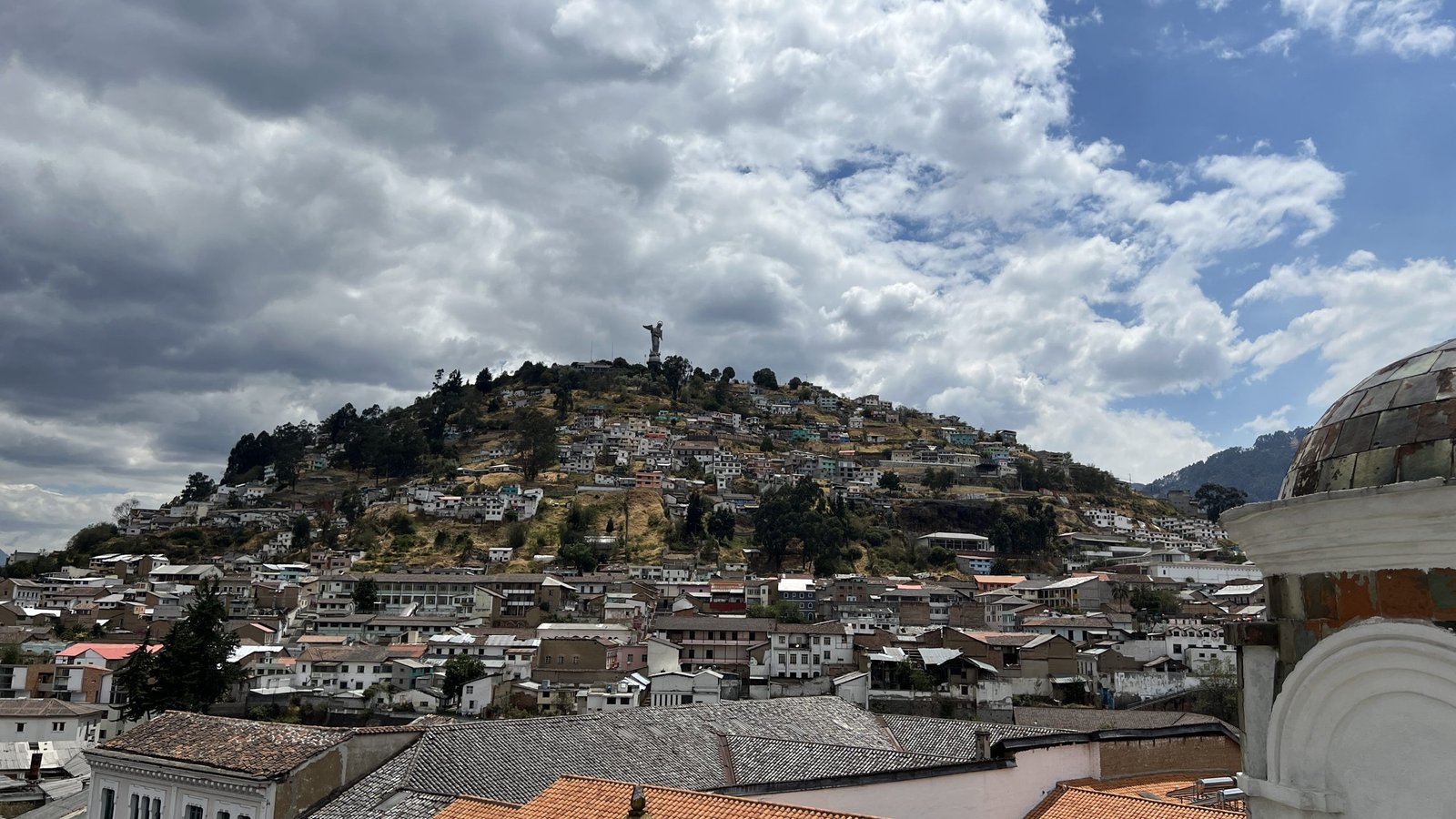
The Franciscans Influence on the Quito School of Art
The San Diego Convent, built by the Franciscans, is the scene of the legend of Padre Almedia. The Franciscans encouraged the blending of European techniques with indigenous aesthetics and materials, fostering a unique syncretism that defined the Quito School.
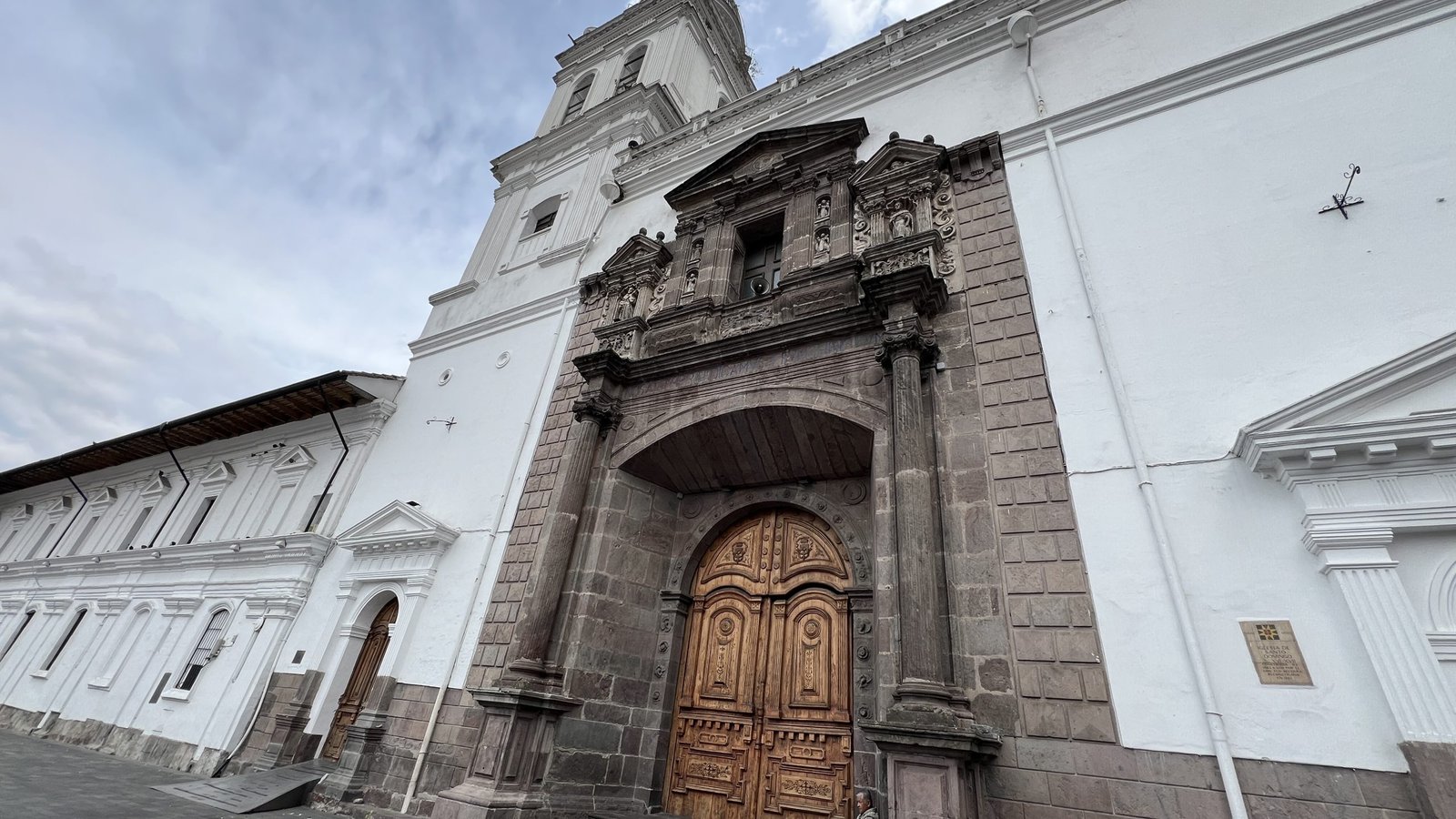
I arrive greeted by what I think are two statutes wearing mirrored costumes until suddenly they start to move, rhythmically as they beckon me to follow them.

They are the Danzantes de Quito, students studying tourism in Quito and preserving ancestral traditions.
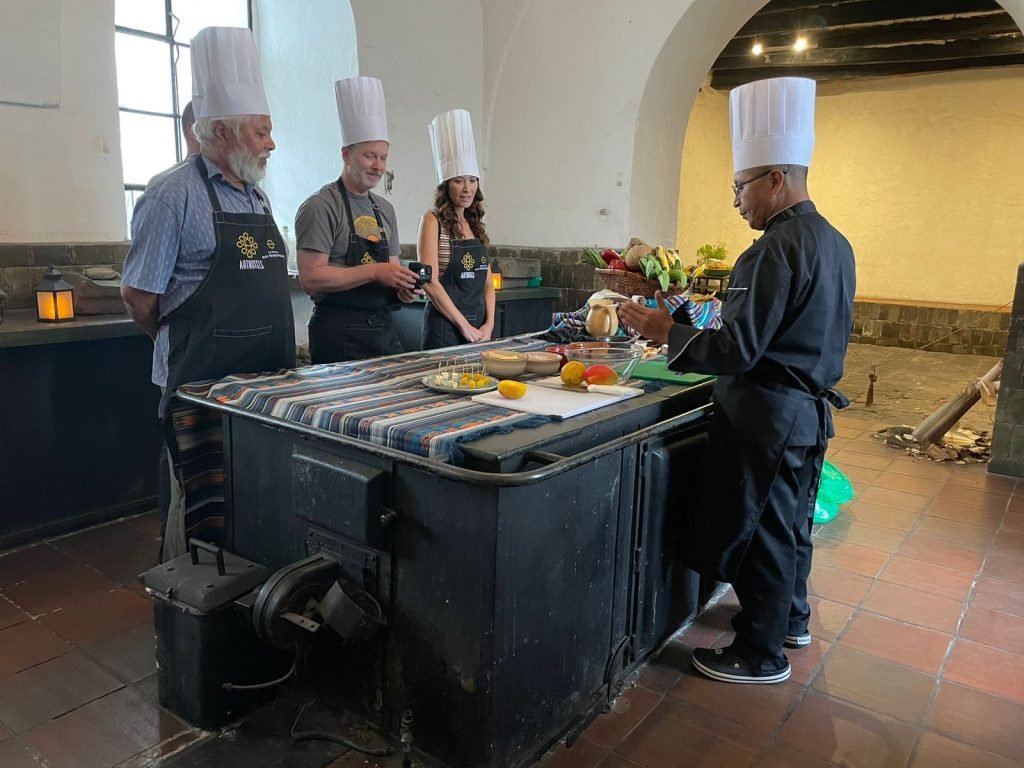
While there I took a cooking class in the convent’s kitchen with the head chef at Hotel Mama Cuchara. He taught me to cook ceviche using local ingredients.
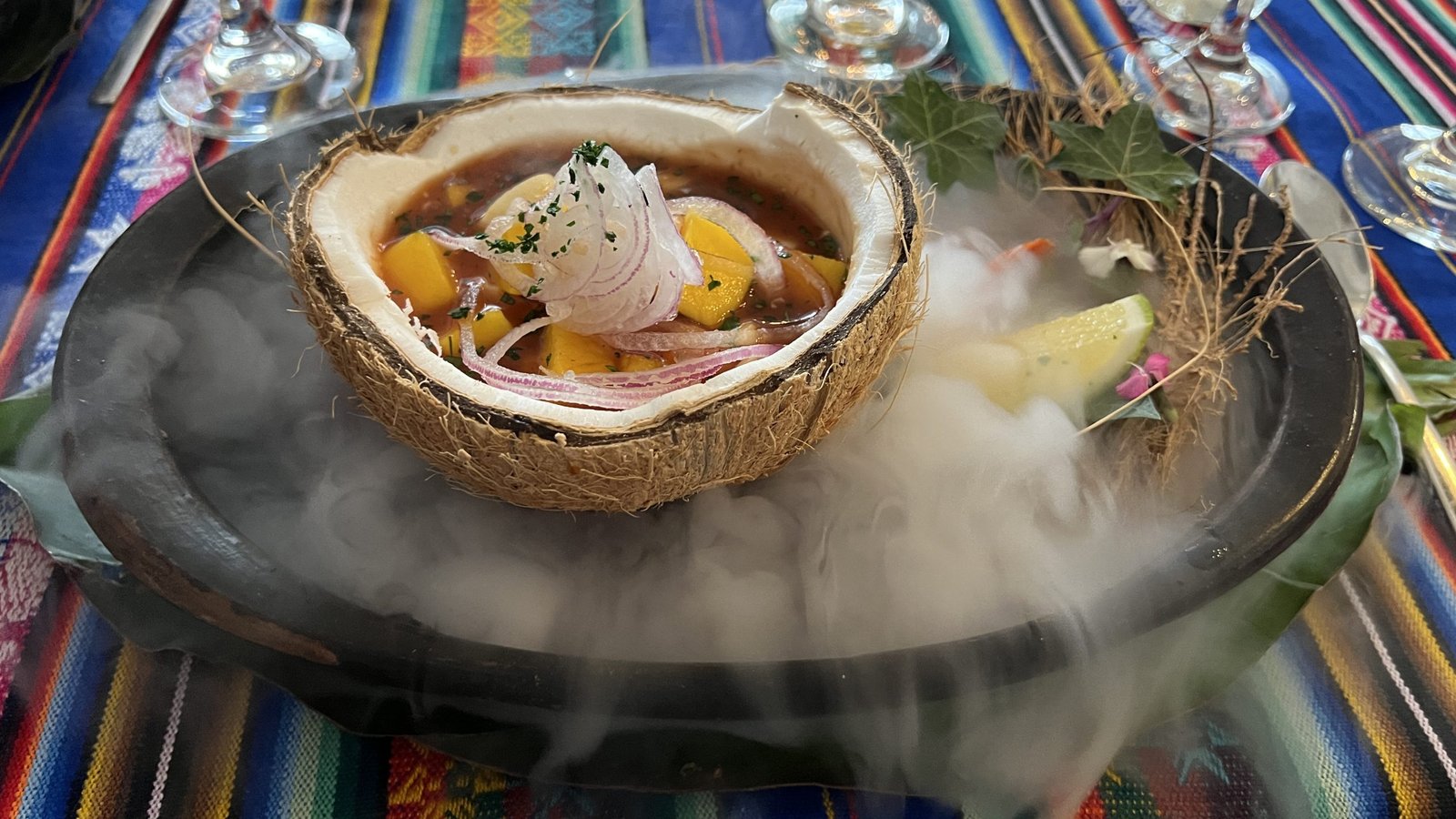
The Franciscans established artisan workshops to train indigenous and mestizo craftspeople in the art of European Baroque styles that infused the native symbols and techniques of local artisans. The Franciscans introduced European artistic techniques, such as oil painting, gilding, and polychrome sculpture.
This style of religious art expresses the Indigenous interpretation of Christian doctrine, incorporating flora, fauna, and Andean landscapes into religious scenes. Artists such as Bernardo de Legarda and Manuel Chili (Caspicara) emerged from the Quito School, producing iconic works under the Franciscans’ tutelage and influence.
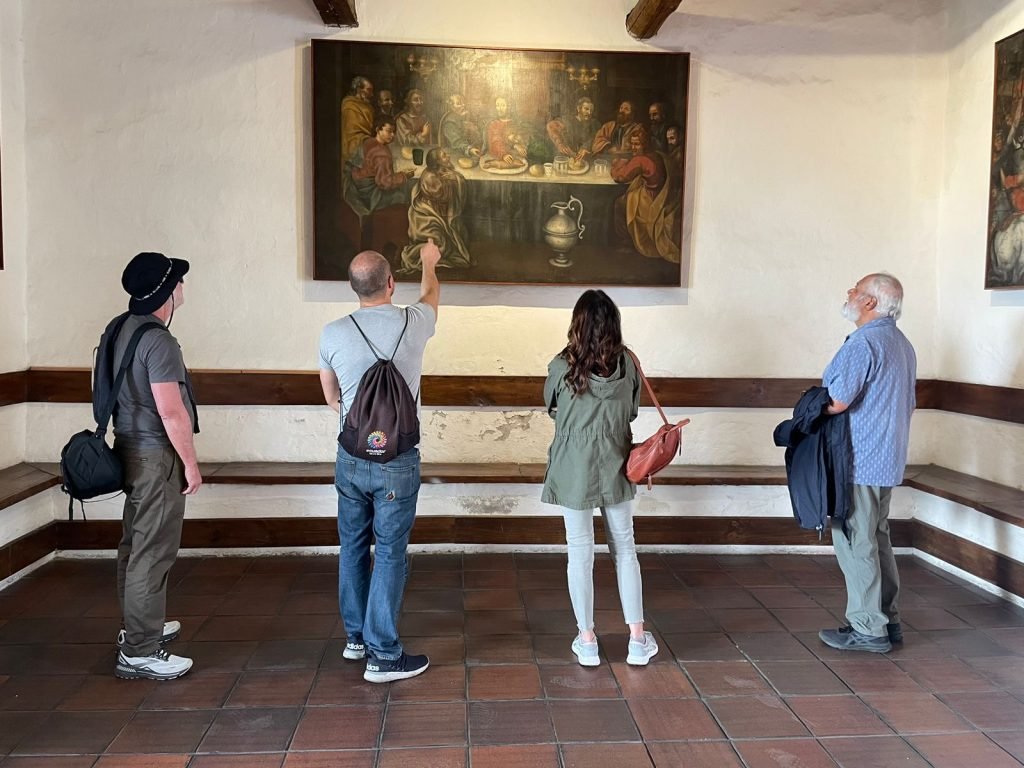
The Franciscan Order also founded the Church of San Francisco, located in Quito’s historic center, on the Plaza San Francisco. It is part of the San Francisco Monastery, one of the largest and oldest religious complexes in the city, built shortly after the Spanish conquest in the 16th century.
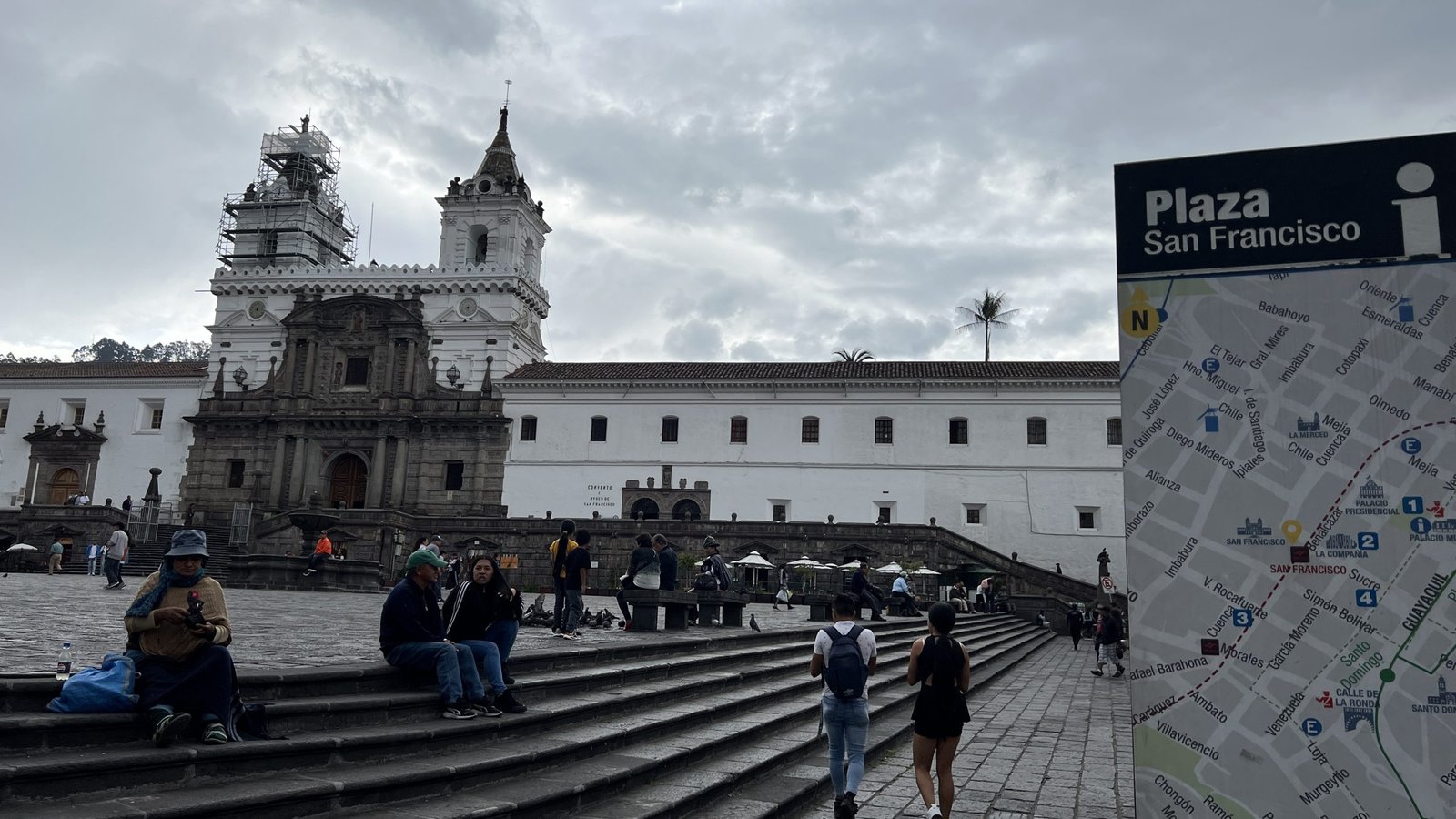
The Franciscans established the church as part of their missionary efforts to evangelize the indigenous population. The complex includes a monastery, a museum, and the church itself, all of which reflect the rich artistic and cultural synthesis characteristic of the Quito School of Art.
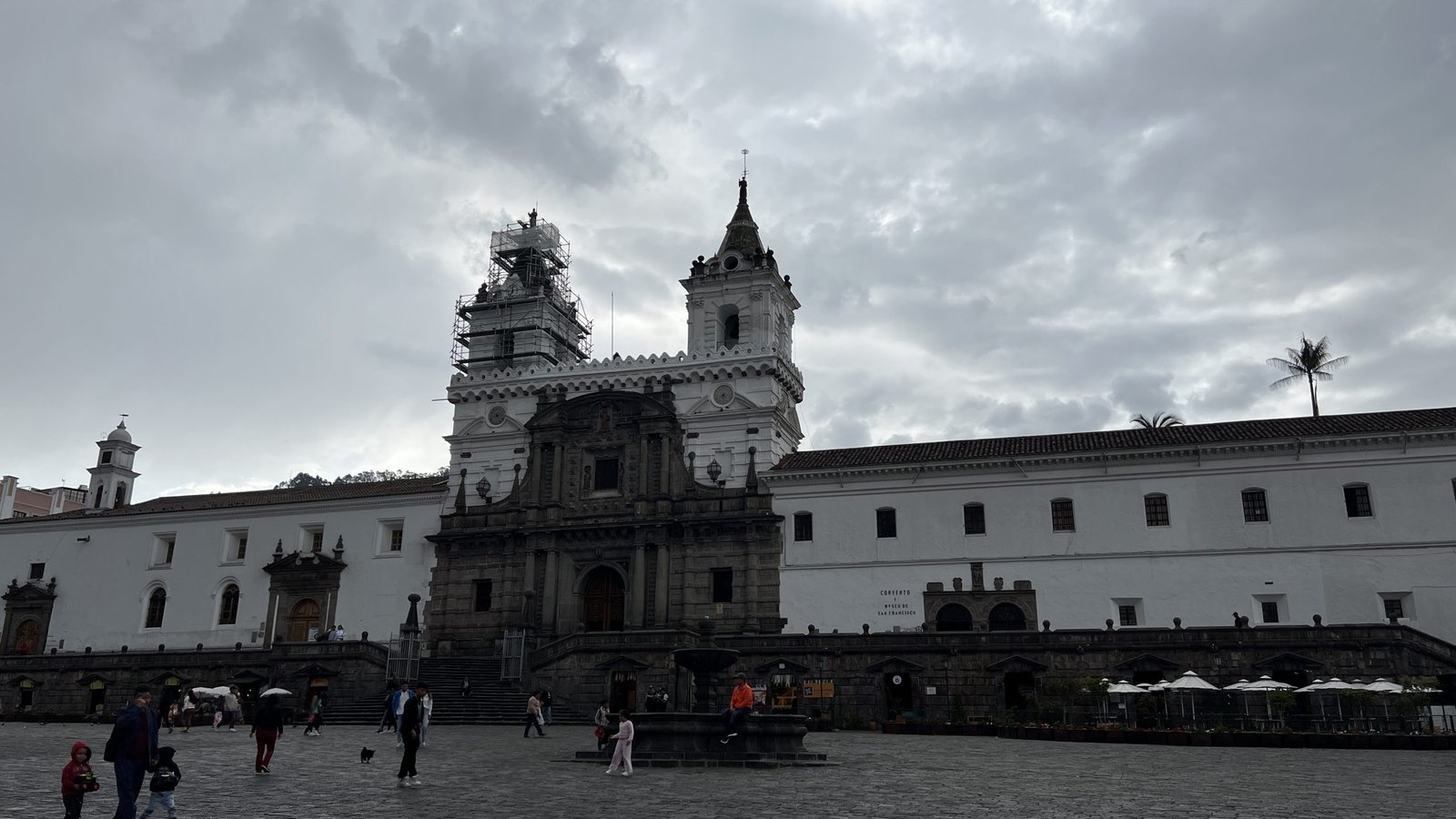
The church holds the original Legarda sculpture titled The Virgin of Quito, which is the basis for the aluminum sculpture that towers over Quito.
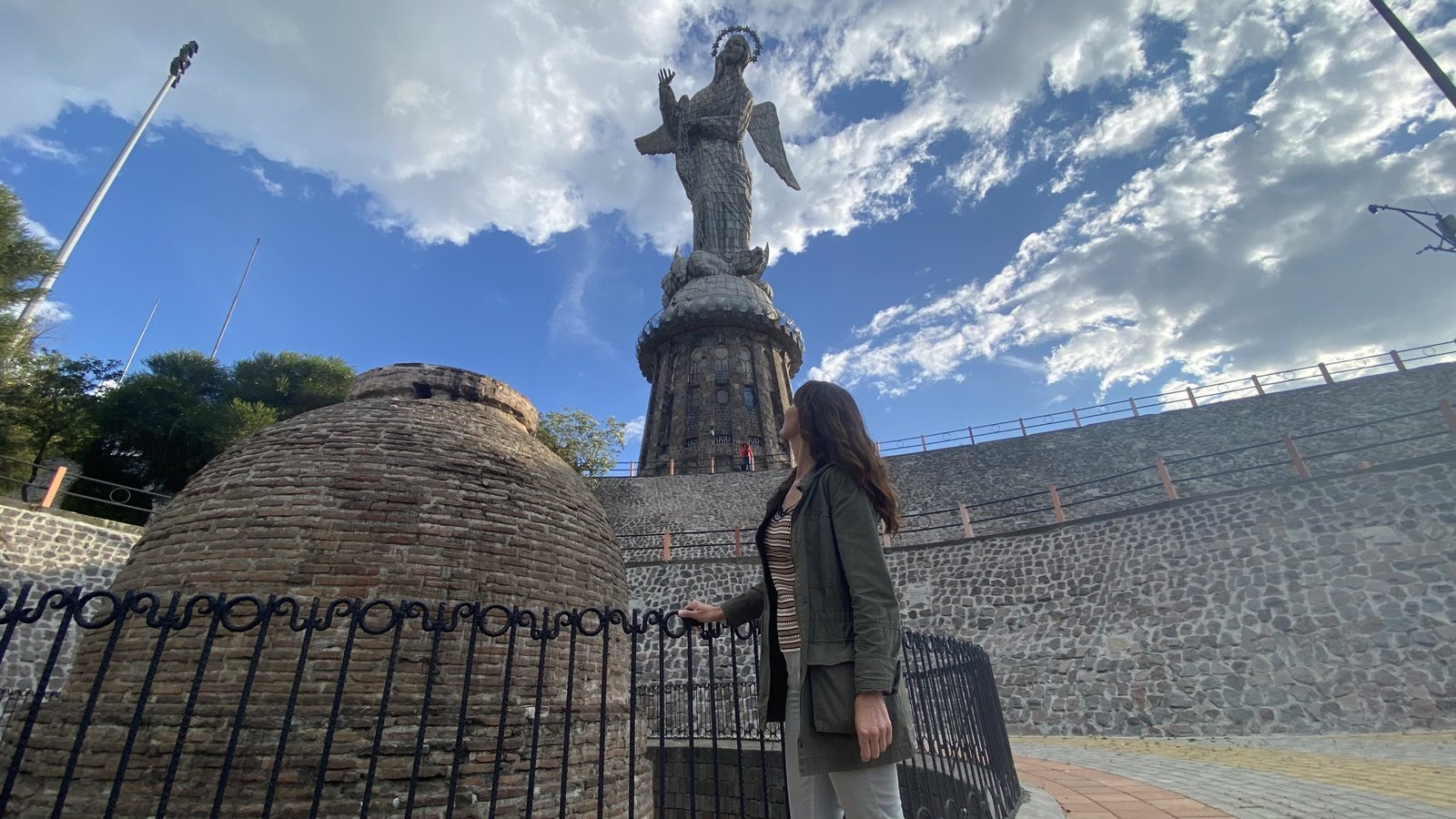
The “Virgin of the Apocalypse” from the Book of Revelation was completed in 1975, stands 148 feet tall, and is composed of 7,000 individual aluminum pieces. It represents the Virgin Mary as a winged Madonna.
The Jesuit’s Influence on the Quito School of Art
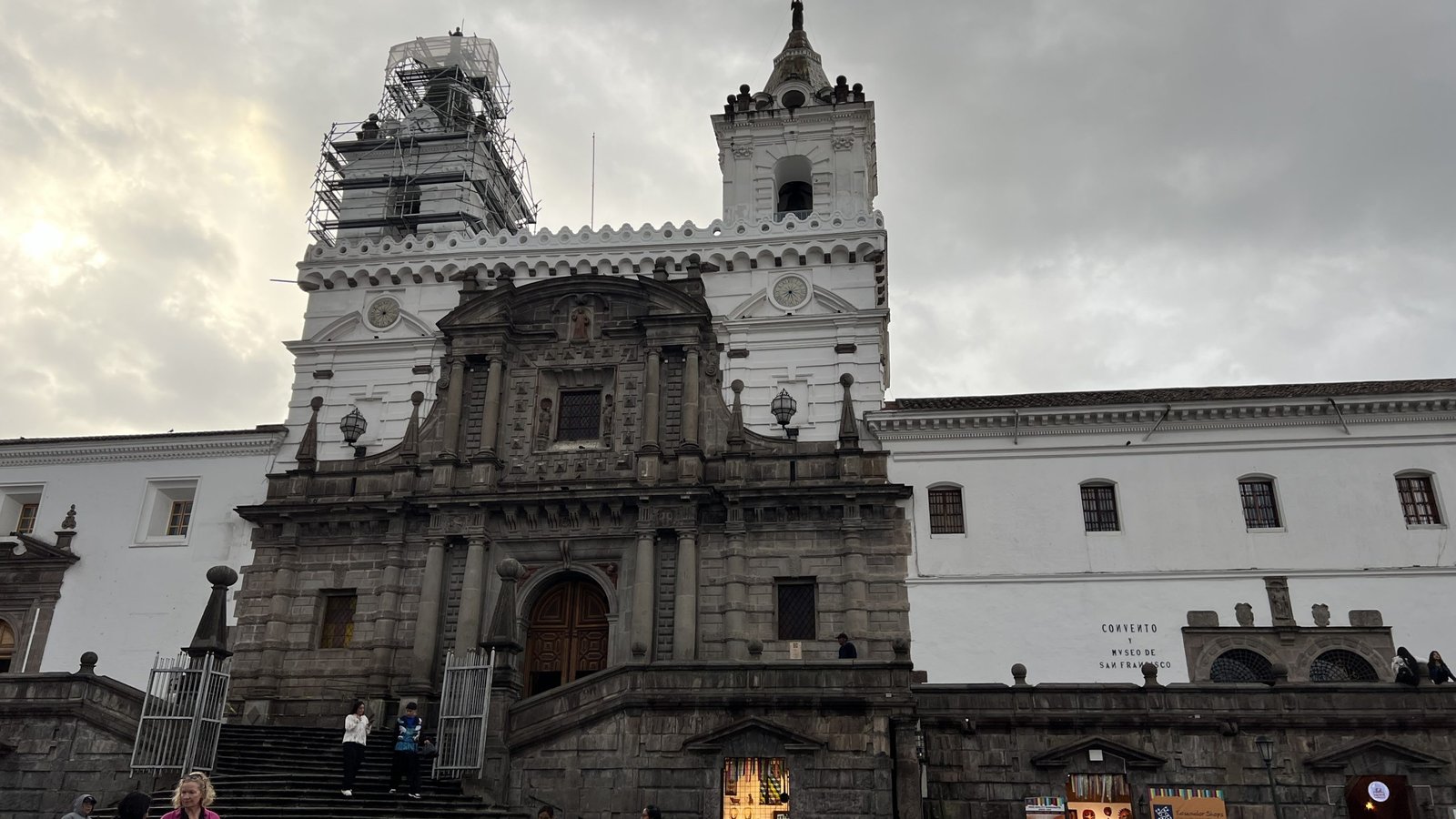
The Jesuits brought their knowledge of Baroque architecture to the construction of the city’s most famous church, La Compañía de Jesús (The Church of the Society of Jesus). The style is defined by dramatic contrasts, ornate details and carvings covered in gold leaf.
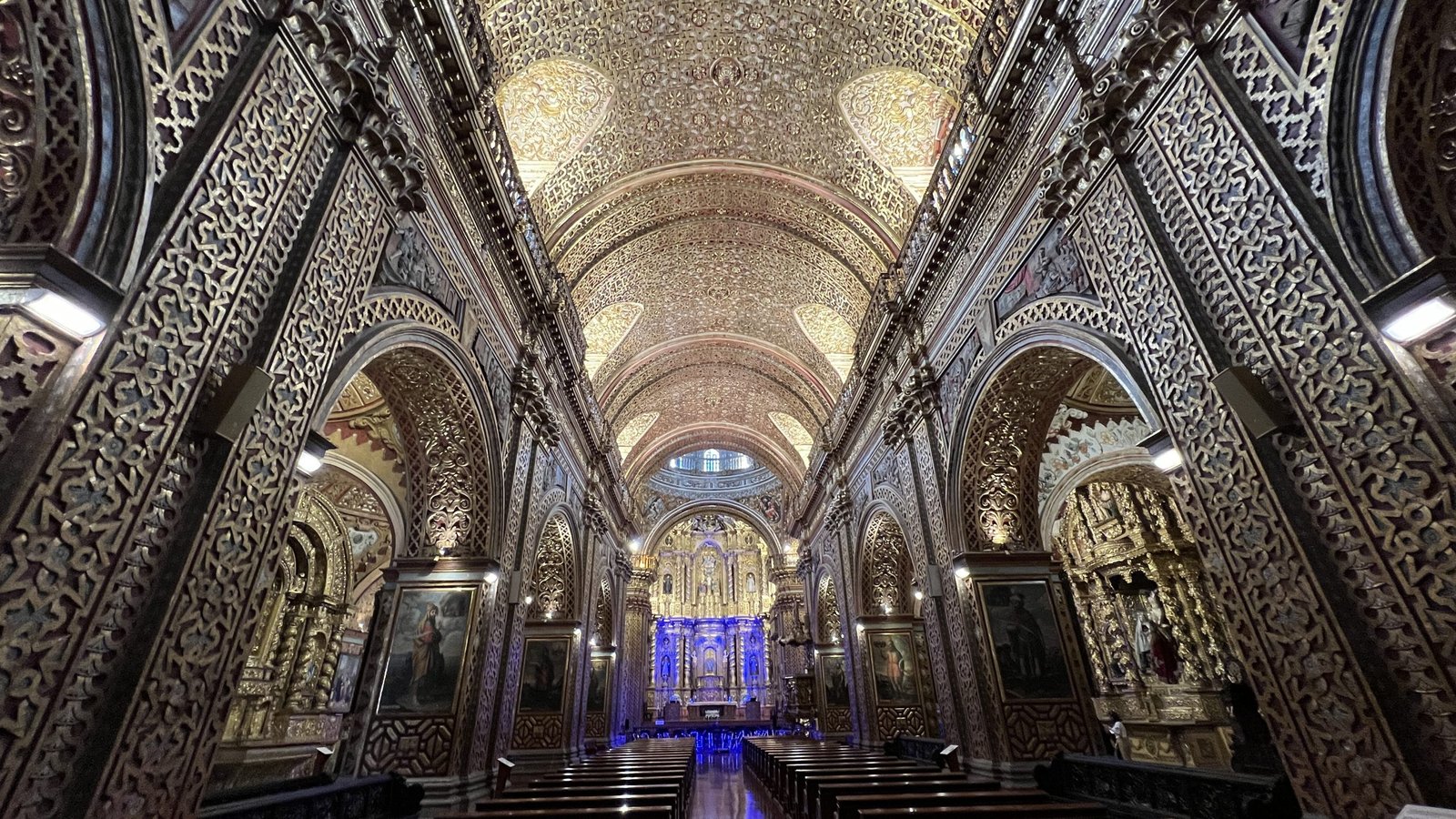
The Jesuits founded schools, colleges, and seminaries, such as the San Ignacio School, where art, theology, and humanities were taught. These institutions served as training grounds for indigenous and mestizo artists, exposing them to advanced techniques and fostering intellectual development.
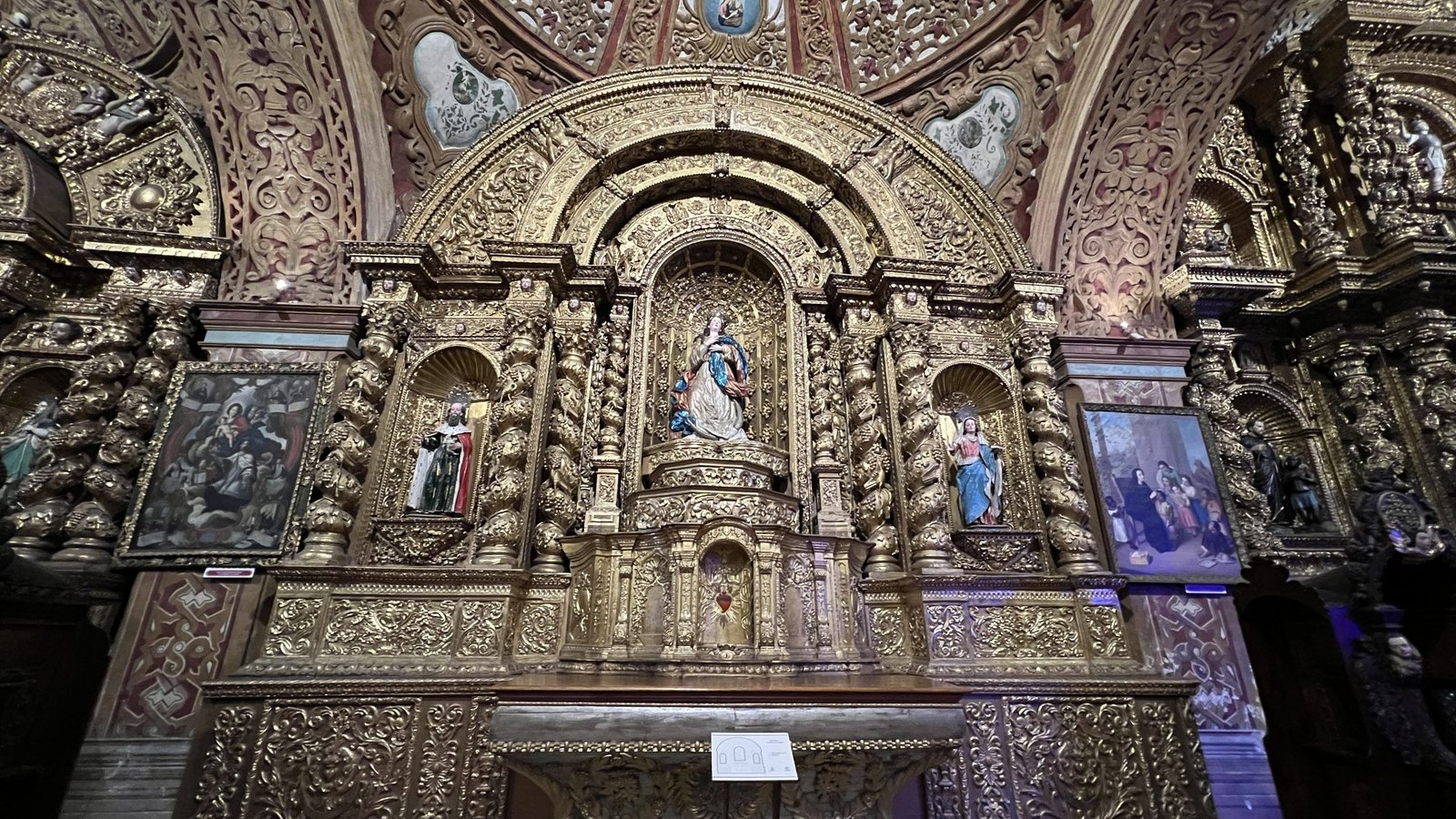
My guide Xavier took me on a tour inside the church where recently, photos were allowed with no flash although filming is prohibited.
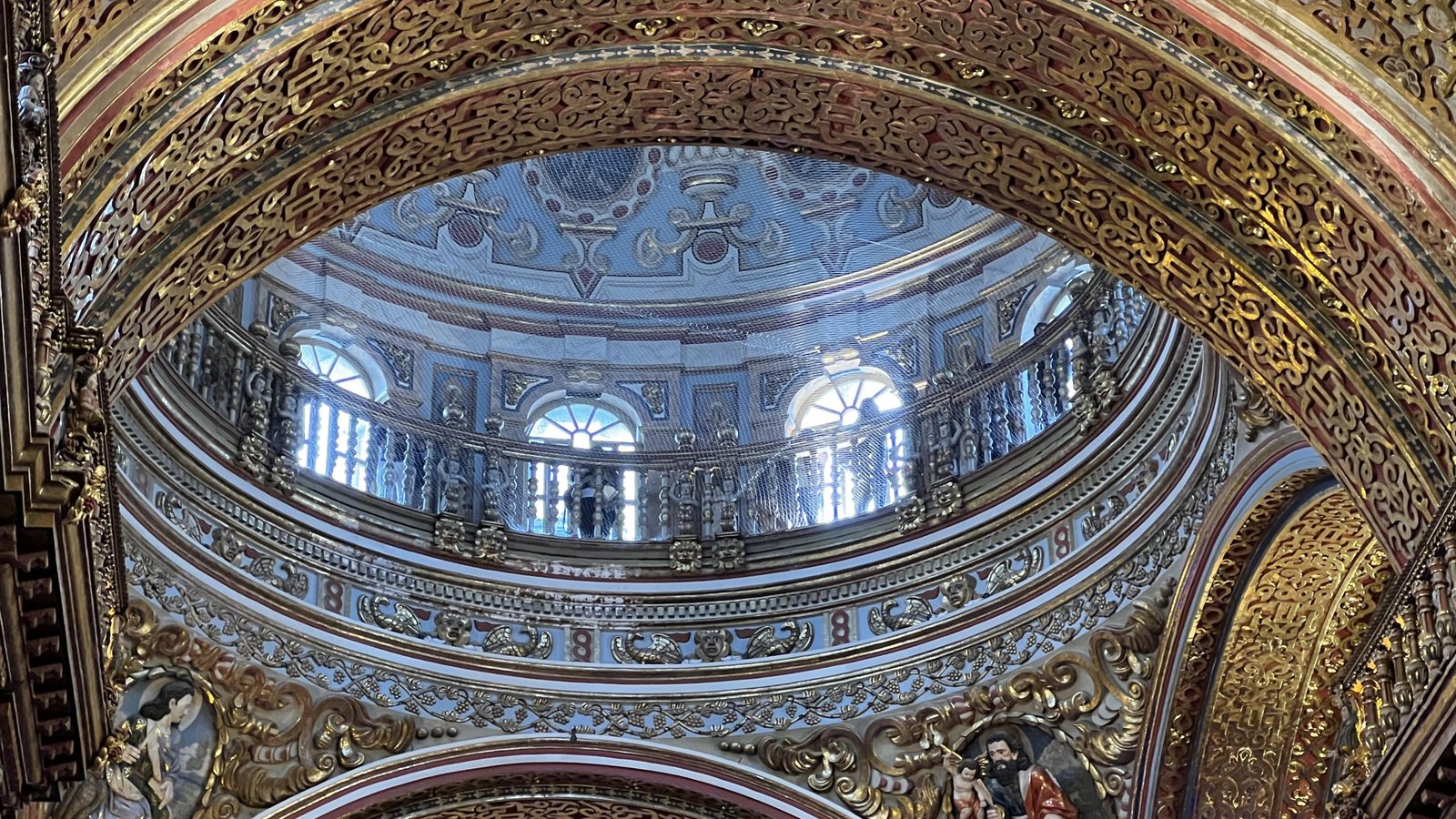
Their educational efforts created a highly skilled group of artists capable of blending European methods with indigenous creativity. Ultimately, the Jesuit order was kicked out of Ecuador.
Like the Franciscans, the Jesuits employed art as a means of evangelization, but they emphasized elaborate, awe-inspiring visual narratives to convey Christian teachings. They sought to engage viewers emotionally and intellectually, aligning with their broader mission of cultural and spiritual conquest.
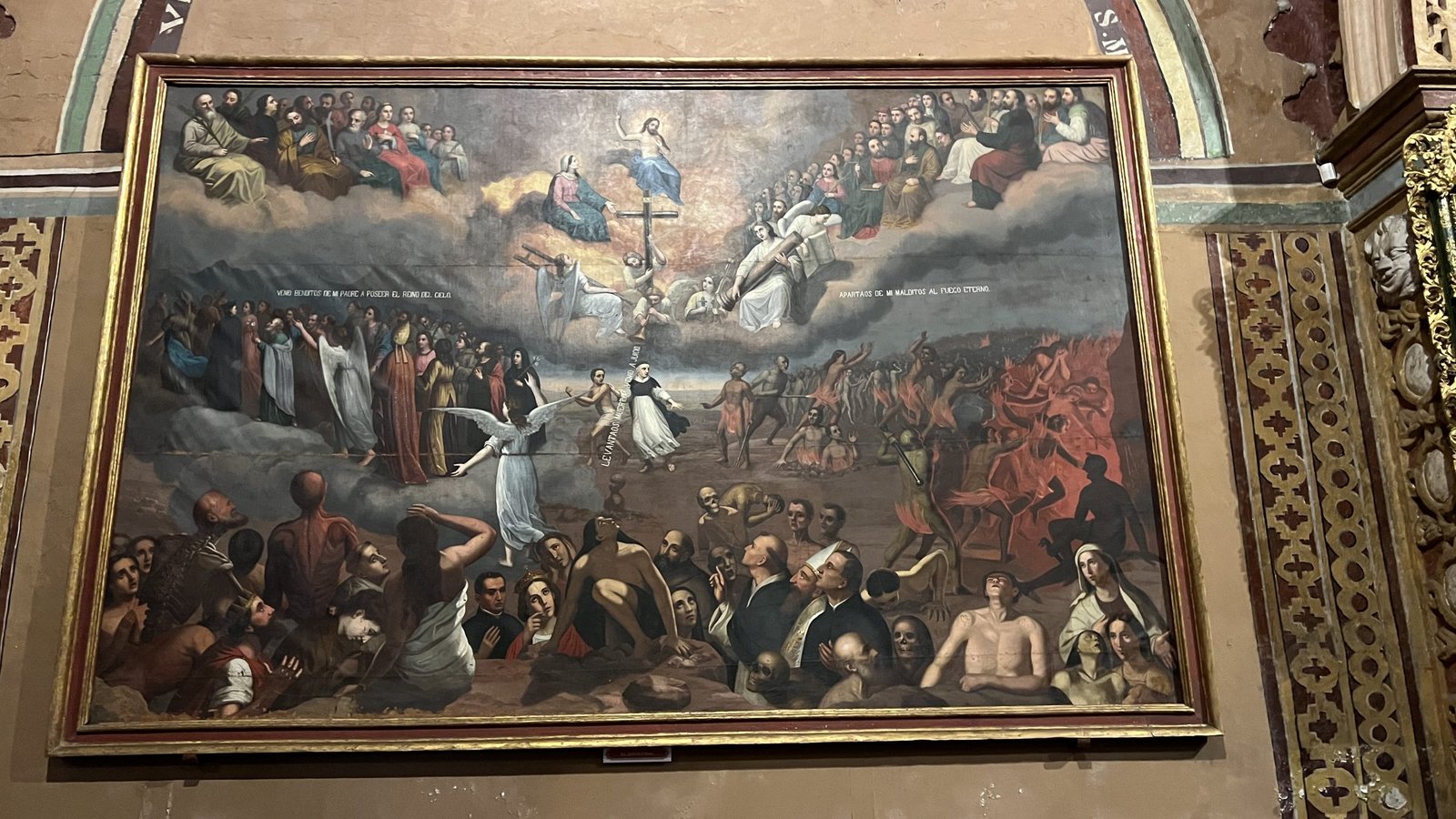
Paintings, sculptures, and architectural designs were used to dramatize religious themes, such as the lives of saints, the Passion of Christ, and the triumph of the Church.
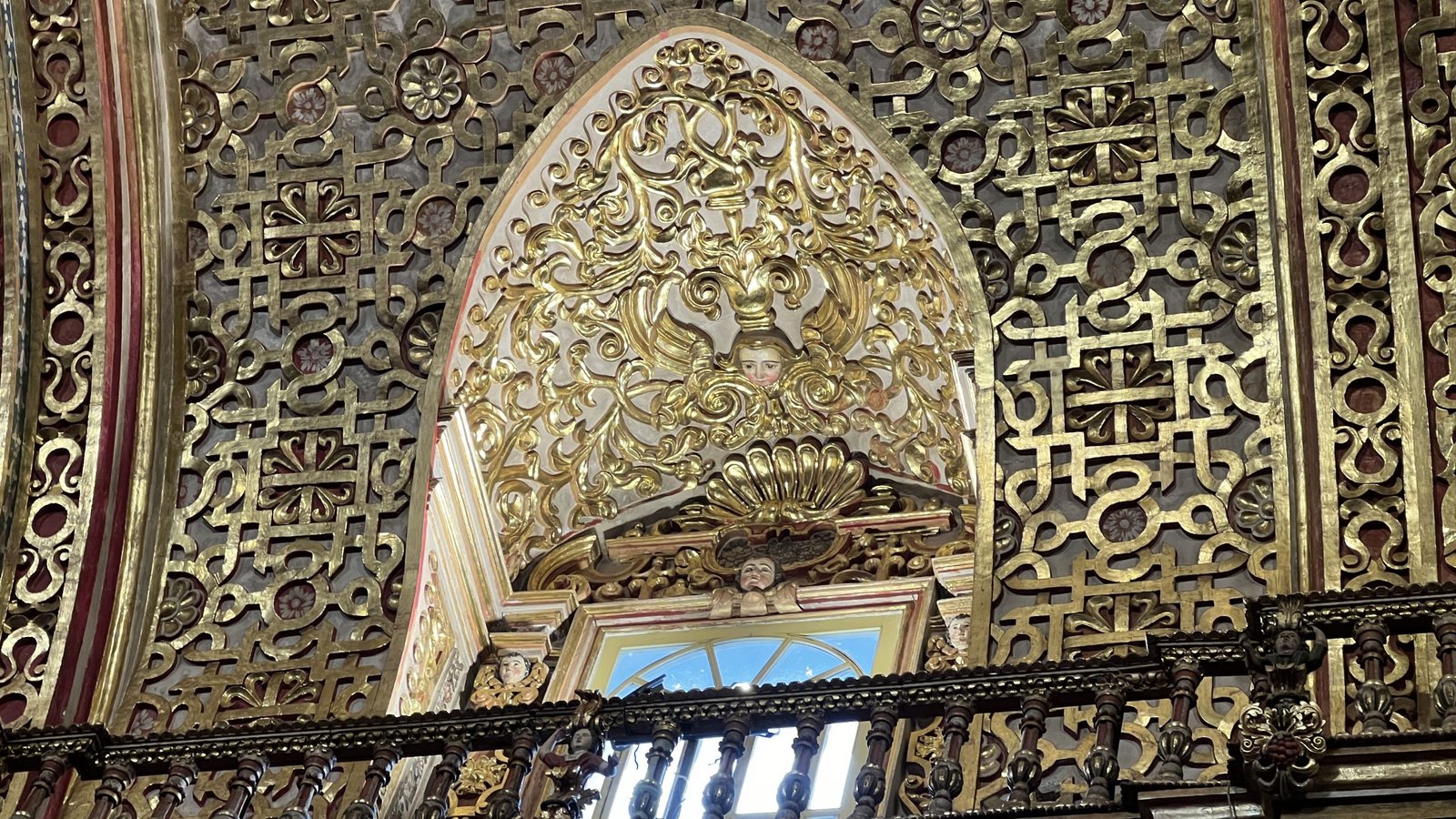
Symbols from Andean cosmology, such as native flora and fauna, were subtly integrated into religious works, creating a unique visual language that resonated with the local population.
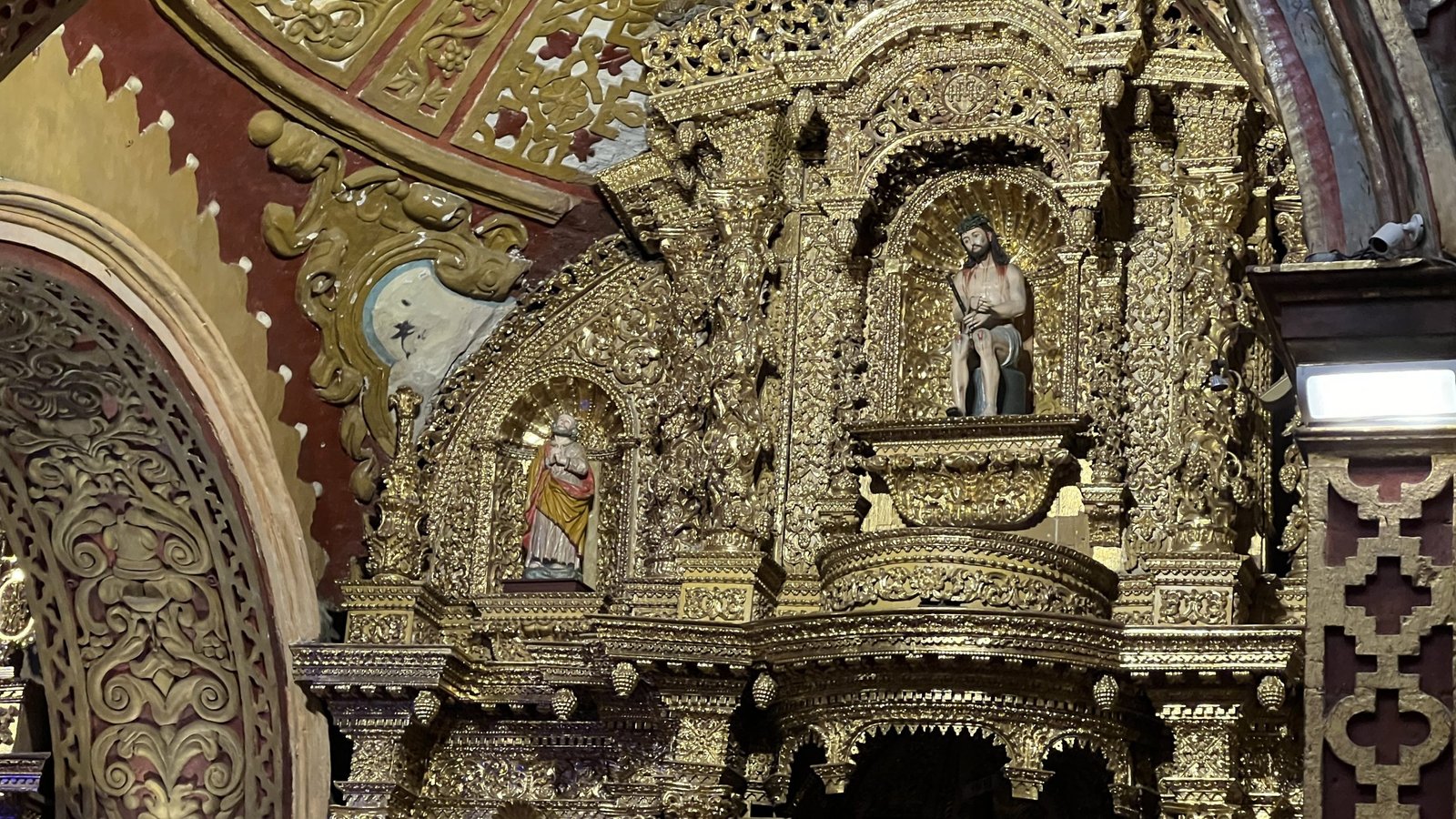
The Jesuits encouraged the development of realistic polychrome sculptures, often depicting vivid expressions of suffering and piety. These works aimed to evoke empathy and devotion. Artists trained under Jesuit supervision mastered techniques such as the application of gold leaf, naturalistic rendering, and anatomical accuracy, further enhancing the sophistication of Quito School artworks.
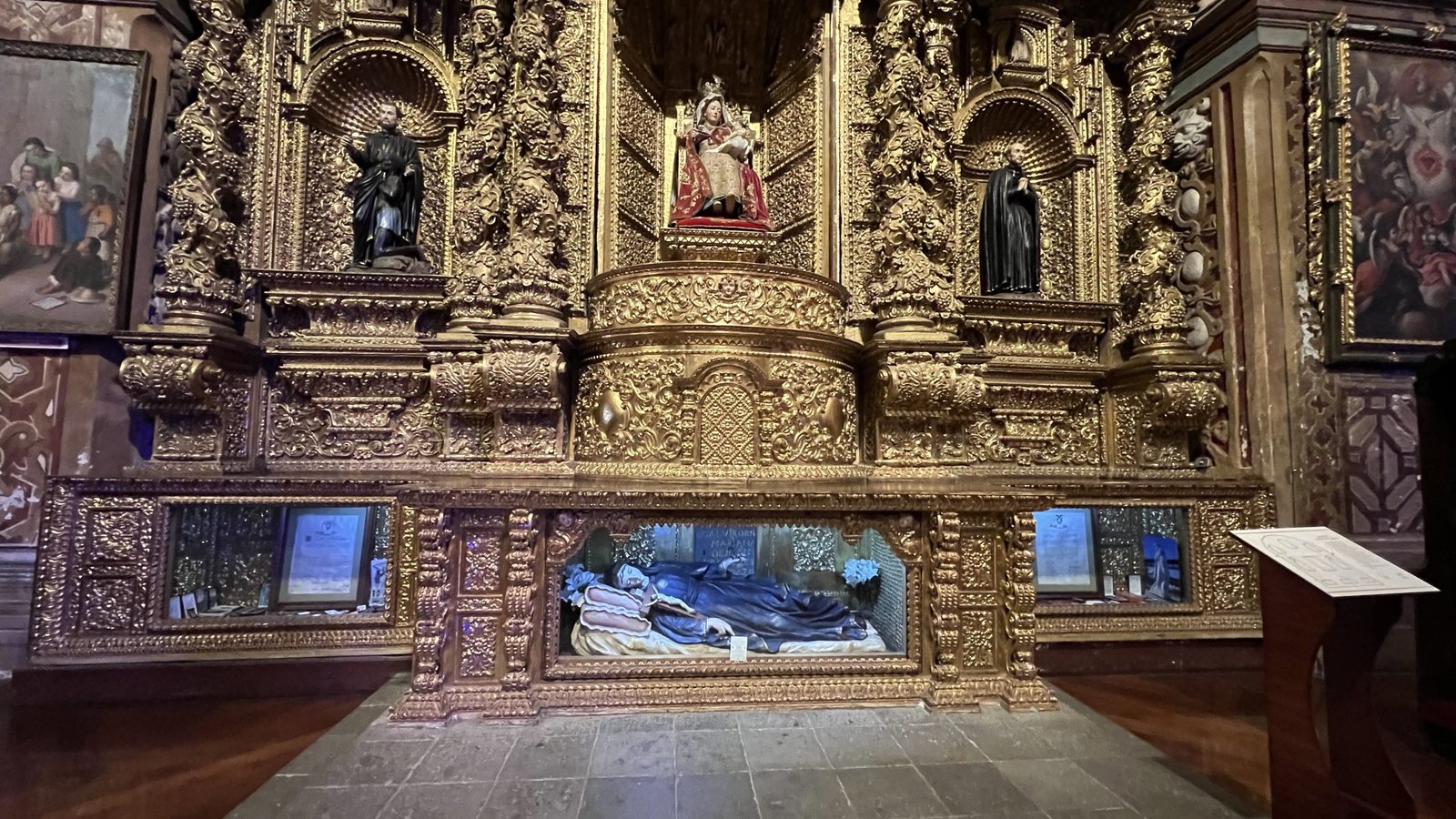
Under Jesuit influence, notable artists such as Miguel de Santiago and Bernardo de Legarda refined their techniques and produced some of the most celebrated works of the Quito School.
The Jesuits also commissioned large-scale projects, including murals, altarpieces, and retablos, which contributed to the overall aesthetic of Quito as a city rich in artistic heritage.
The Augustinians Influence on Quito’s Religous Art
The Cathedral Primada de Quito, one of the oldest churches in Ecuador, resides in the city’s historic center, UNESCO World Heritage Site.
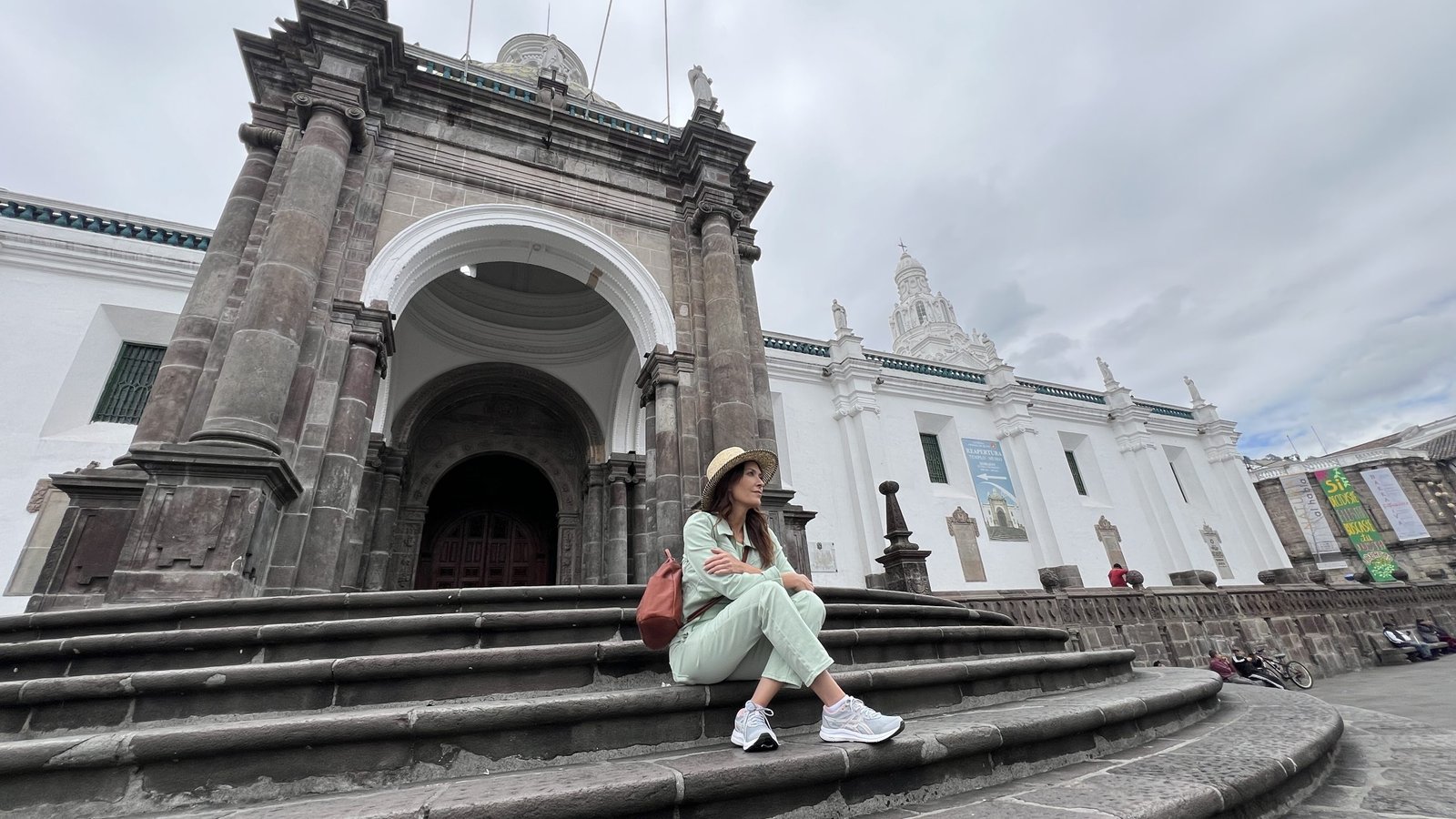
The Catholic Church and the Order of Saint Augustine founded Cathedral Primada de Quito soon after the Spanish Conquest in 1545. The church serves as the seat of the Archbishop of Quito and one of the best examples of the Quito School of craftsmanship.
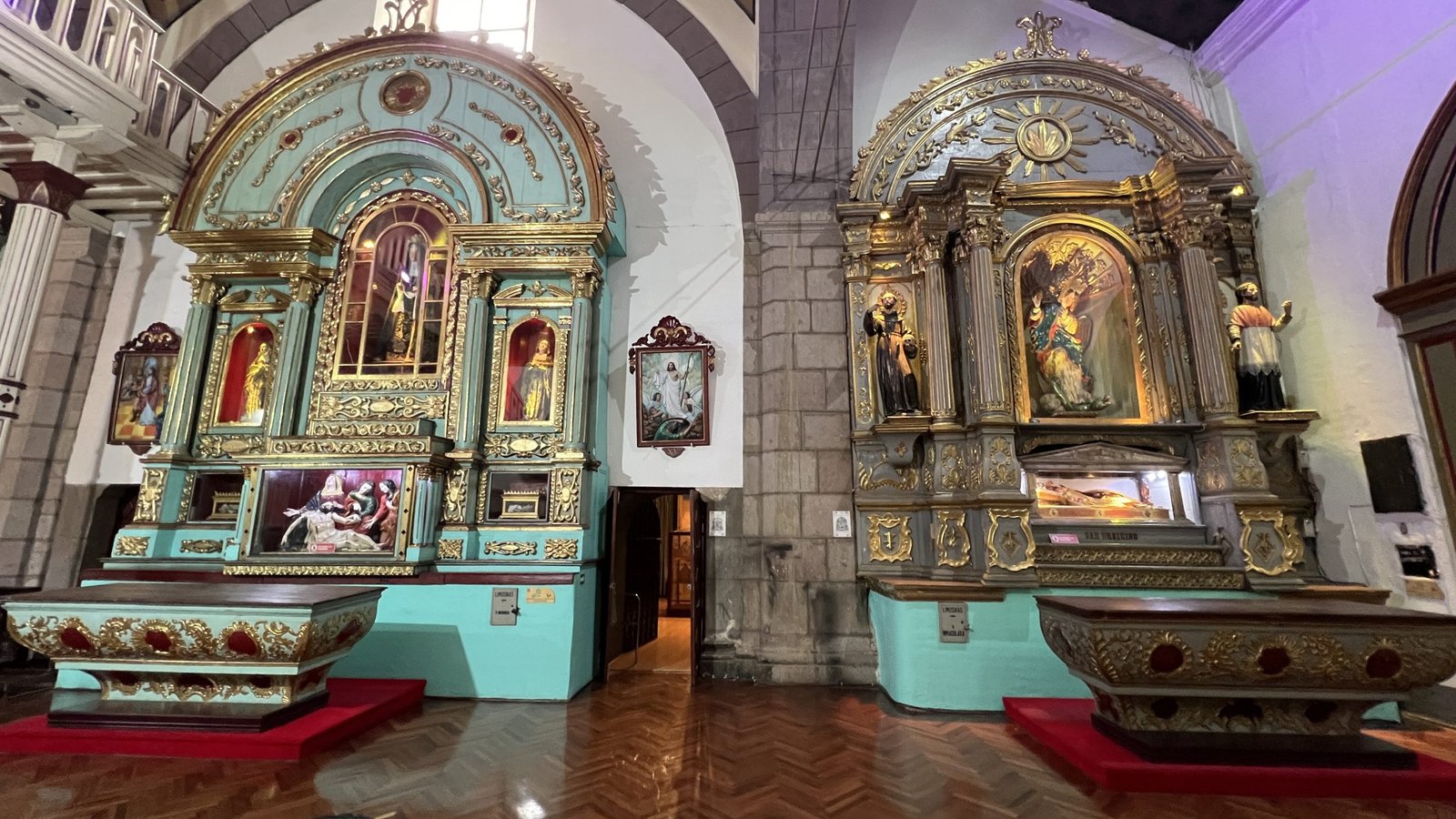
The cathedral’s austere exterior contrasts the ornate interior, which is covered in gold leaf, carvings, and artwork. The cathedral houses numerous masterpieces from the Quito School of Art, including depictions of the Virgin Mary, saints, and the Passion of Christ, created by celebrated artists like Miguel de Santiago and Manuel Chili (Caspicara).
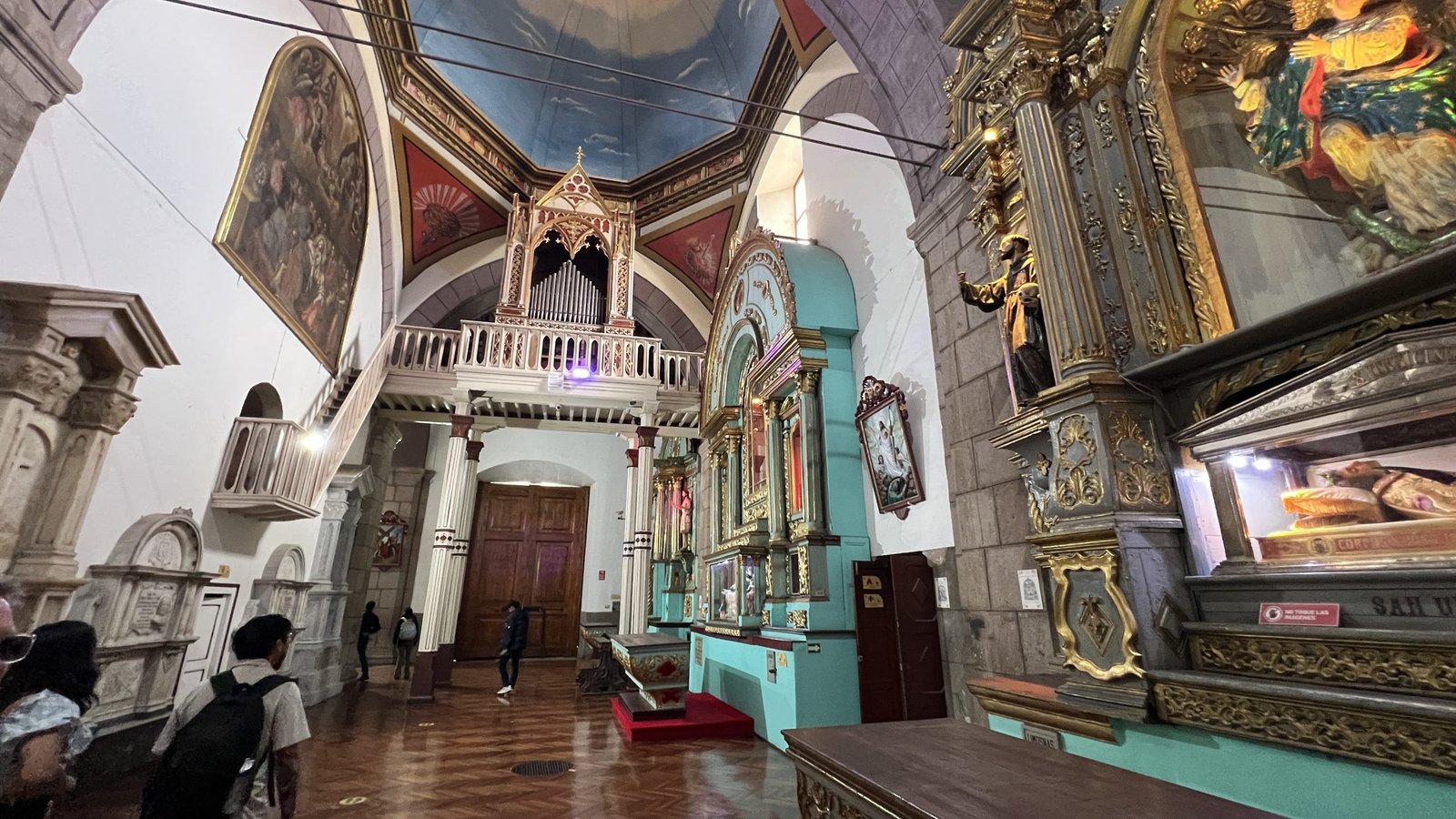
The main altar, dedicated to the Assumption of the Virgin Mary, is a centerpiece of the church’s grandeur. Beneath the cathedral lie crypts where many notable figures in Ecuadorian history are interred, including Antonio José de Sucre, a hero of Ecuador’s independence.
For a small fee, you can climb to the cathedral’s rooftop, for an up close look at the yellow and green checkered cupolas and for a sweeping view of the city. A narrow passage way of 54 winding steps leads up to the rooftop. If you are claustrophobic or uncomfortable with confined spaces, be advised that you’ll have to navigate steep, narrow steps in near darkness as you climb.
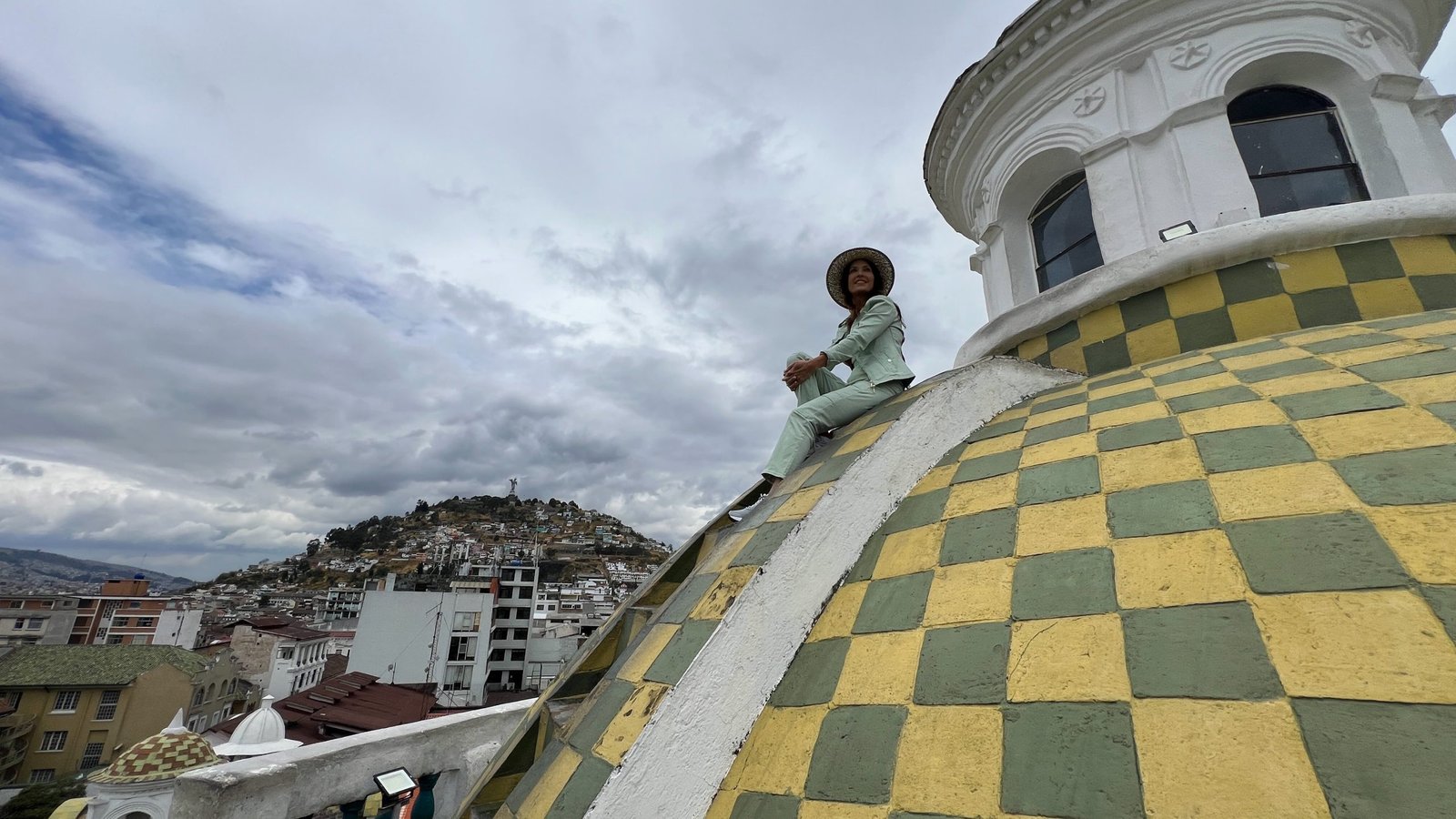
The Quito School of Art is a testament to the fusion of Spanish Baroque and Indigenous creativity, born out of Spanish colonial evangelism. Its unique religious artform continues to inspire visitors and reflect Ecuador’s cultural identity. By blending faith, art, and resistance, the Quito School remains a defining element of Ecuador’s historic and artistic legacy.
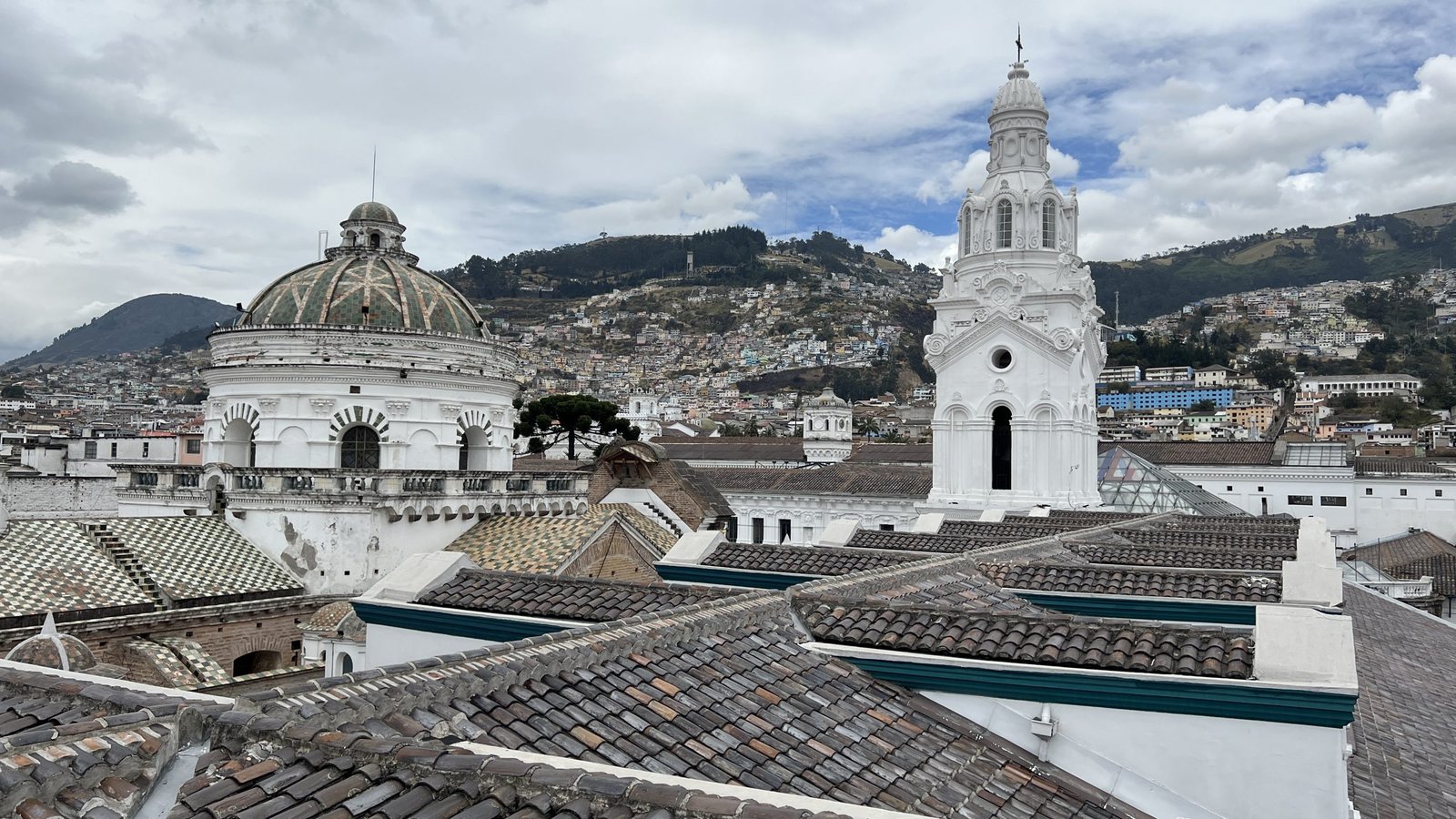
Here’s My Takeaway
Visiting these churches challenges you to take in more detail than the senses can process; it’s overwhelming, breathtaking, and otherworldly. Interiors tempt to concentrate and seek out the hidden in, plain sight indigenous symbols. The experience can feel like a scavenger hunt or a game of I Spy with sensory overload that leaves you with a deep appreciation of the attention to detail and skill required to create such stunning beauty.
Ready to plan your trip?
Check out this comprehensive Quito Travel Guide for the best recommendations on where to stay, must-visit attractions, and unforgettable experiences!
FAQ’s About Quito School of Art
-
What is the Quito School of Art?
The Quito School of Art is a unique artistic tradition that emerged in Ecuador during Spanish colonial rule. It combines European Baroque techniques with Indigenous creativity, resulting in paintings, sculptures, and designs that reflect both Catholic evangelism and Andean culture.
-
How did Spanish colonial evangelism shape Quito’s art?
Spanish colonial evangelism played a key role in shaping the Quito School of Art. Missionary orders like the Jesuits, Franciscans, and Dominicans trained Indigenous and mestizo artists in European techniques. These artists incorporated local Andean elements, such as flora, fauna, and cosmological symbols, creating a distinct fusion of styles.
-
Where can I see the Quito School of Art?
You can experience the Quito School of Art in Quito’s historic churches and monasteries, including:
La Compañía de Jesús: Known for its ornate gold-leafed interiors.
San Francisco Church: Houses the original Virgin of Quito sculpture.
Santo Domingo Monastery: Features works by notable artists like Miguel de Santiago and Bernardo de Legarda.
Cathedral Primada de Quito: Displays intricate carvings and religious masterpieces. -
Why is the Quito School of Art unique?
The Quito School of Art is unique for its blend of European Baroque techniques and Indigenous symbolism. While reflecting Catholic religious themes, it incorporates Andean cultural elements, such as local plants, animals, and spiritual motifs, making it a distinct and culturally rich artform.
-
Who are the notable artists of the Quito School of Art?
Some of the most notable artists of the Quito School of Art include:
Miguel de Santiago: Known for his dramatic religious paintings.
Bernardo de Legarda: Creator of the iconic Virgin of Quito sculpture.
Manuel Chili (Caspicara): Renowned for his lifelike polychrome sculptures.
Explore More Unique Travel Destinations Showcasing World-Class Design and Creativity
Santiago Calatrava: Valencia’s Starchitect and Architectural Tourism Draw
Ceramic Designs in Valencia: Inspiration & Latest Trends
Travel Guide to Valencia: Top Attractions and Advice
Cuba’s Emerging Foodie Scene at La Guarida
6 Must-Do Activities in Augsburg, Germany: Top Attractions and Experiences









